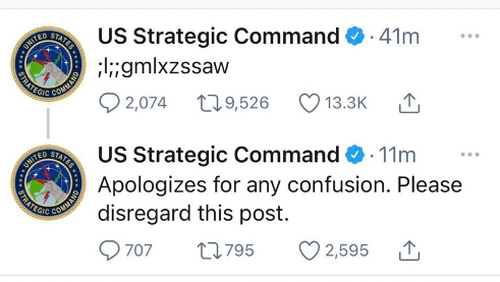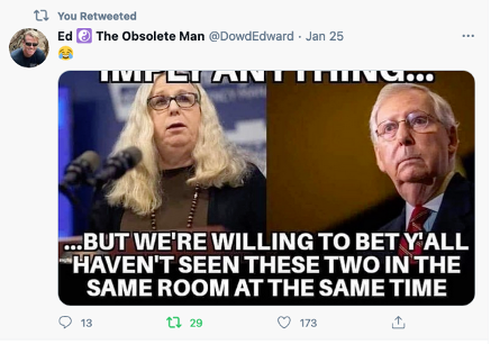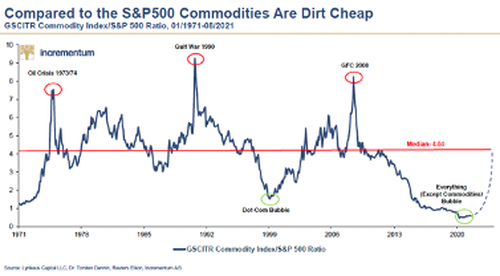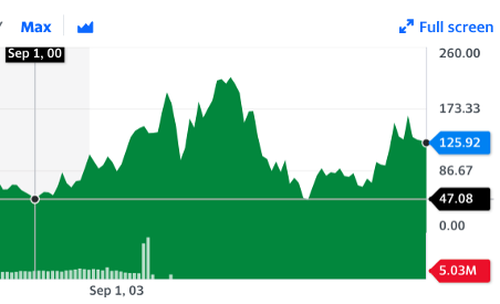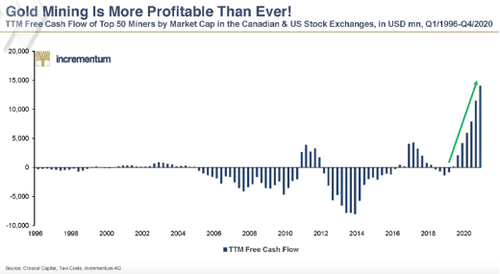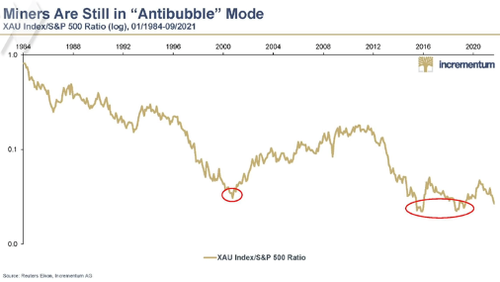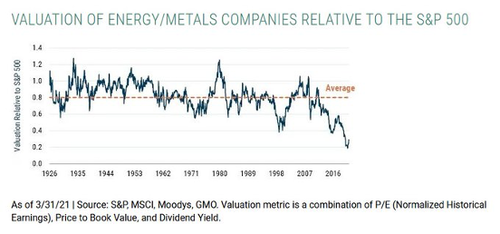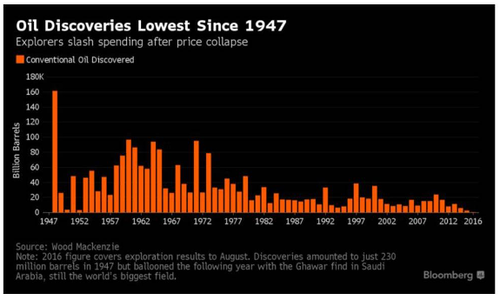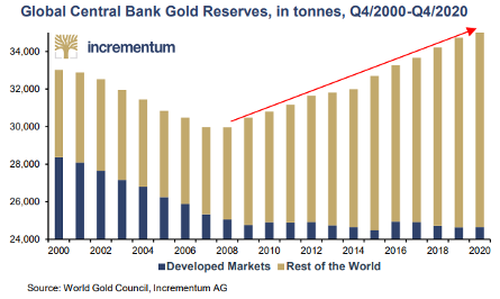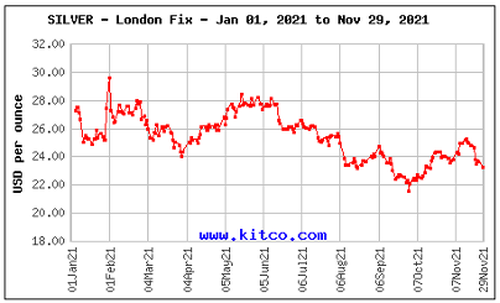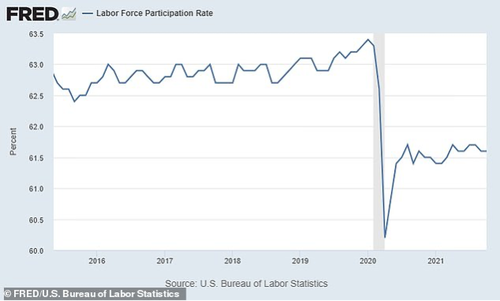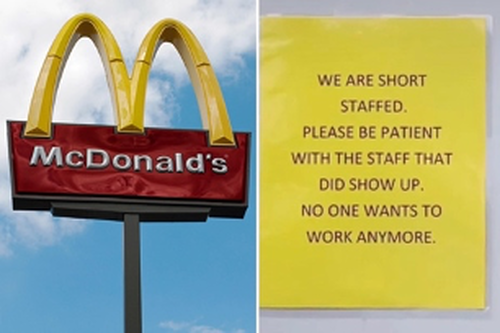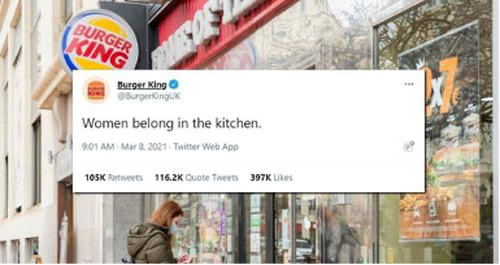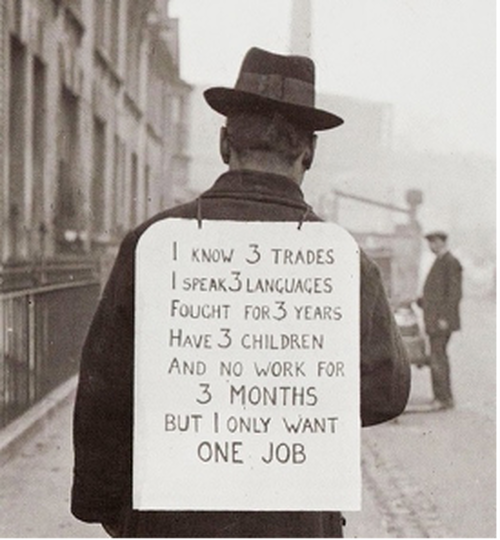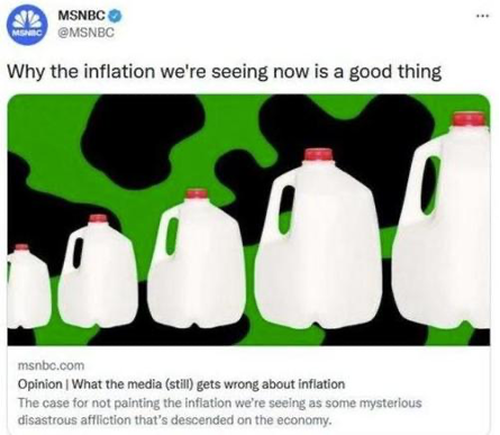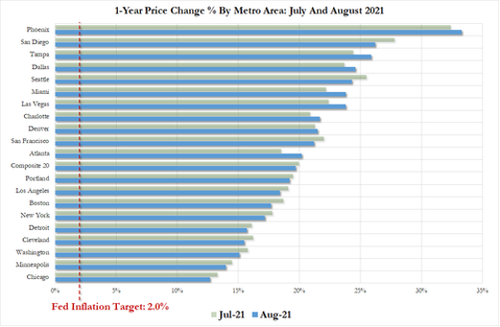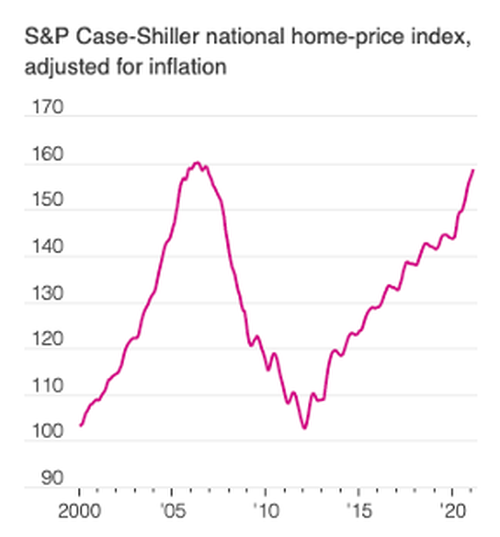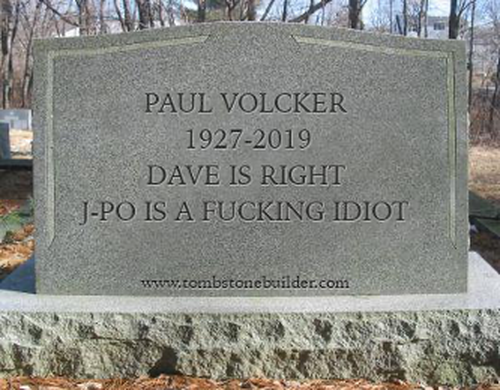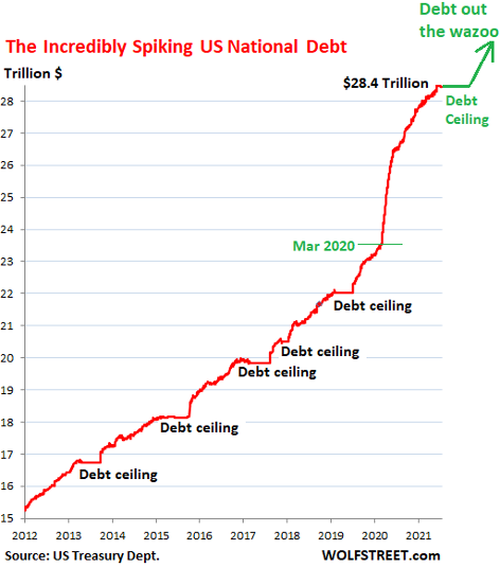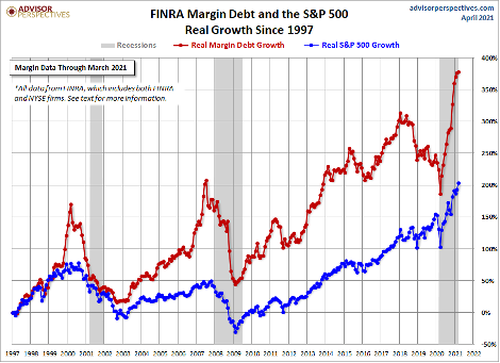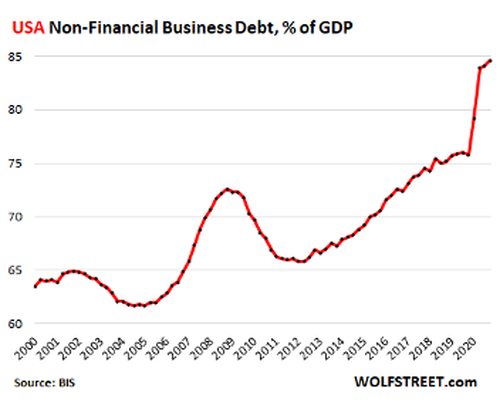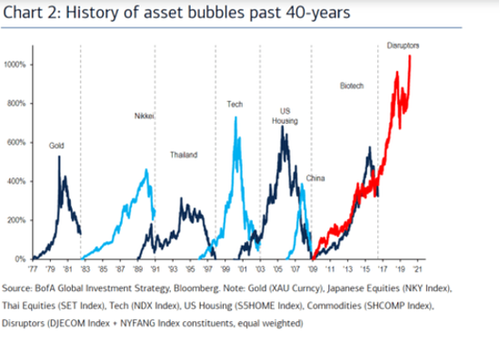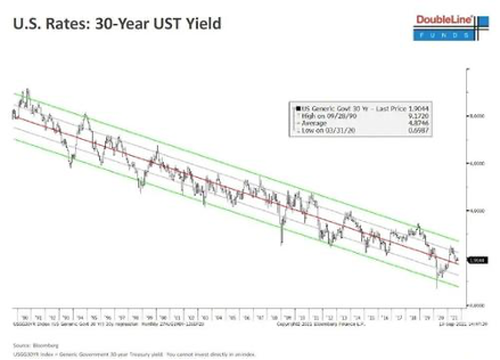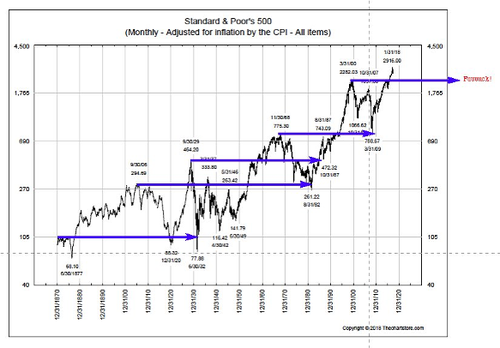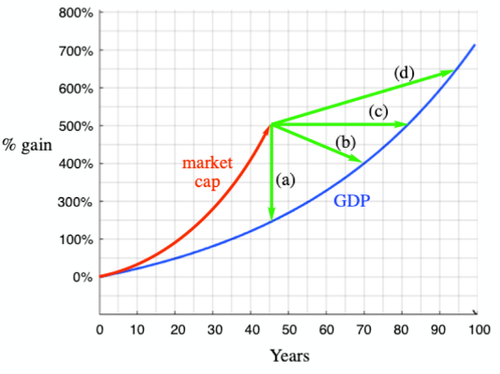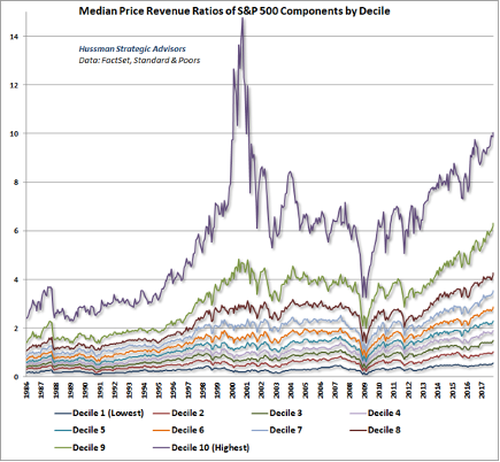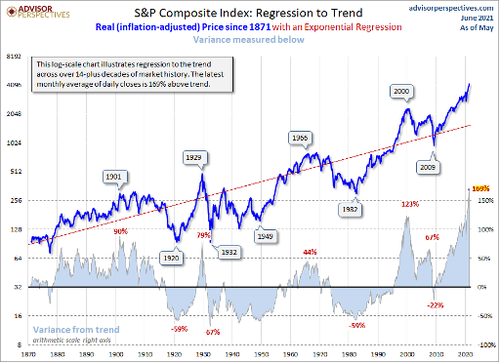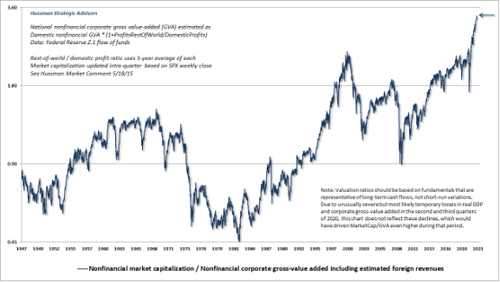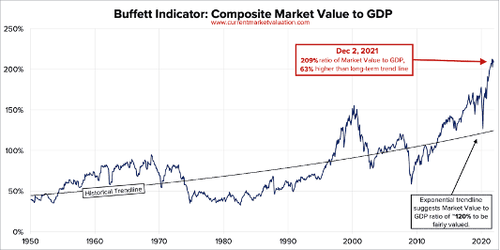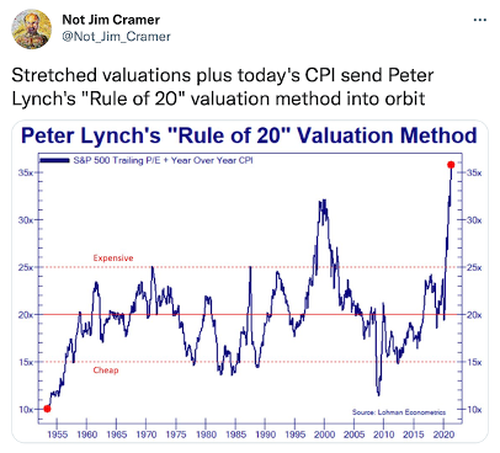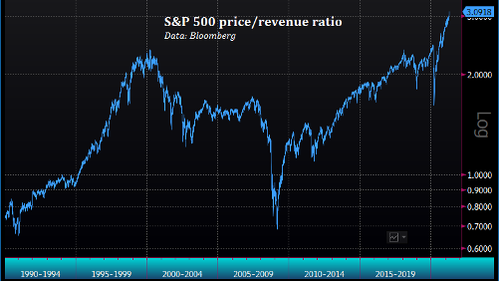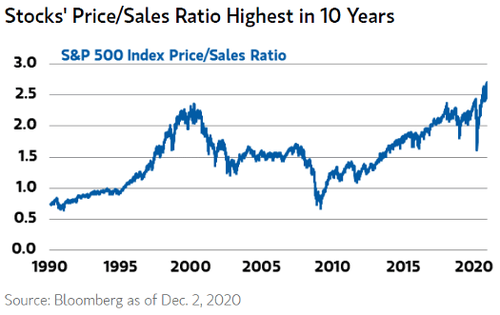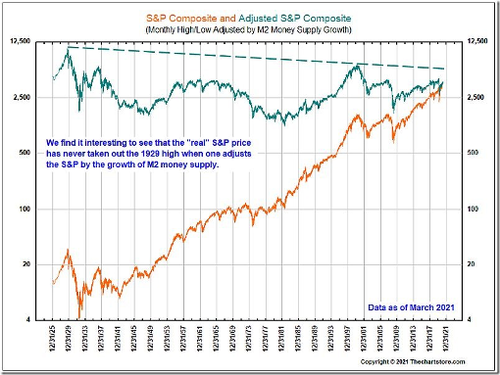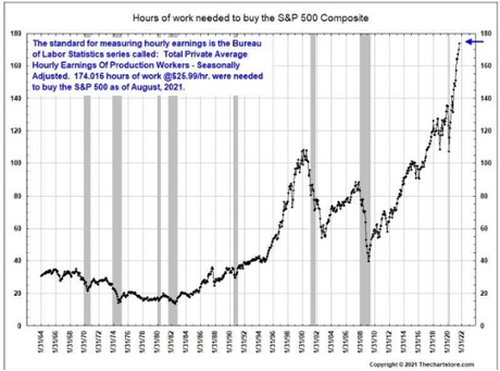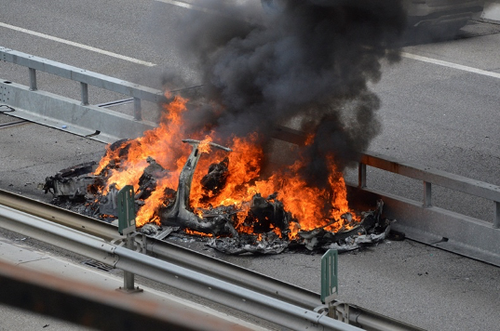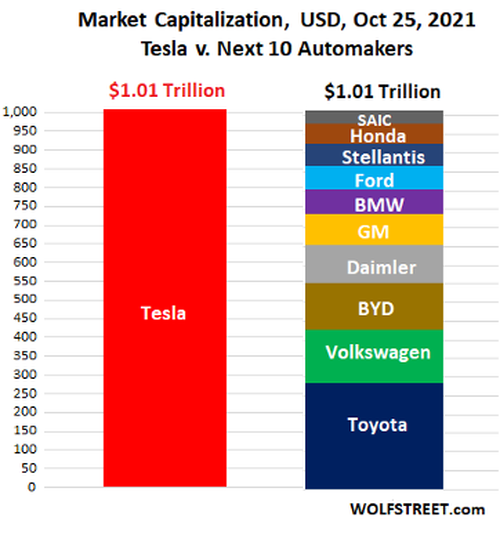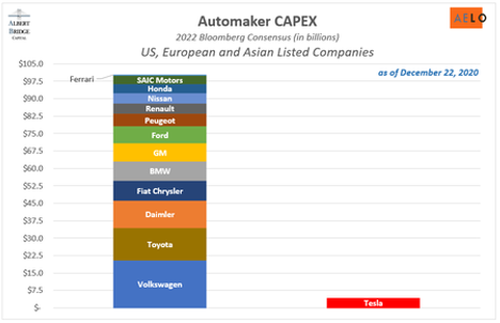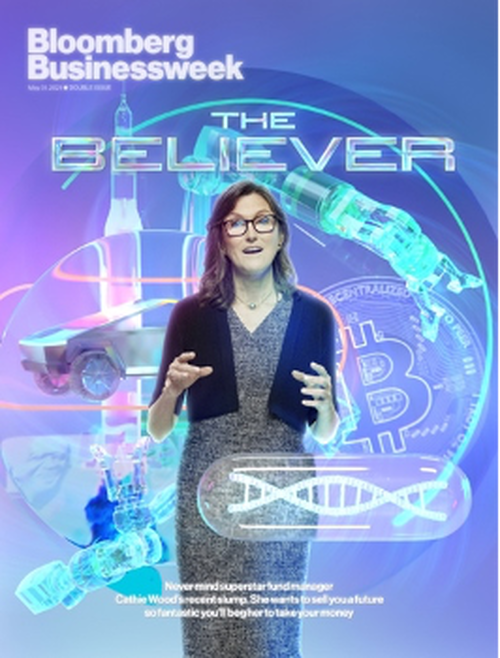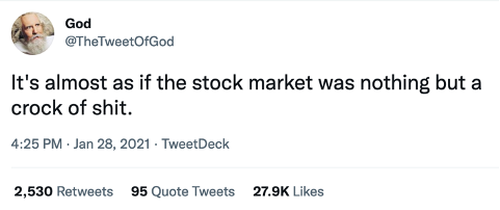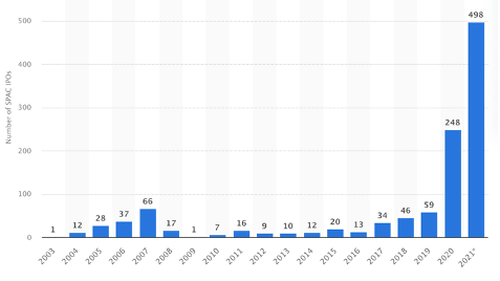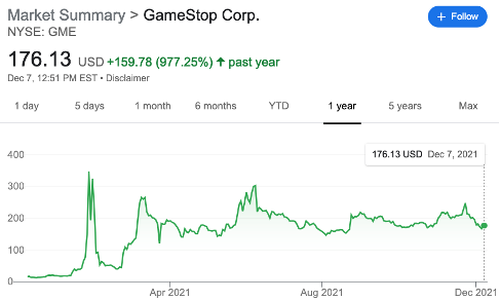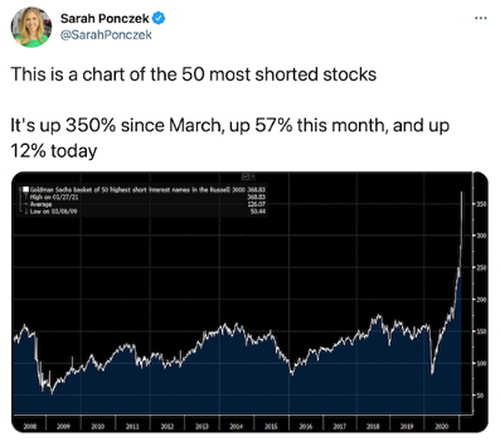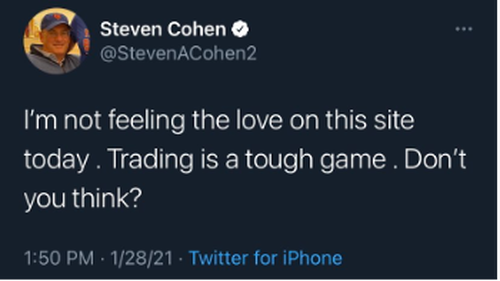Sunday Collum: 2021 Year In Review, Part 1 – Crisis Of Authority & The Age Of Narratives
Authored by David B. Collum, Betty R. Miller Professor of Chemistry and Chemical Biology – Cornell University (Email: dbc6@cornell.edu, Twitter: @DavidBCollum),
Dave: You do lack self control, but I learned and laughed making my way thru this.
~ Larry Summers (@LHSummers), former Secretary of the Treasury
Every year, David Collum writes a detailed “Year in Review” synopsis full of keen perspective and plenty of wit. This year’s is no exception.
Introduction
I’ve been trying to reach you about your car’s extended warranty. What began more than a dozen years ago as a synopsis of the year’s events in markets and finance for a few friends morphed beyond my control into a Year in Review (YIR)—an attempt to chronicle human folly and world events for the entire year. It captures key moments before they slip into the brain fog. The process of trying to write a coherent narrative helps me better understand WTF just happened and seminal moments that catch my eye.
By far my favorite end-of-year recap for the last ten years. Finished it yesterday. Once again David hasn’t disappointed. He’s on my I want to go to dinner with list.
~ Jim Pallotta (@jimpallotta13), money manager and former owner of Boston Celtics
I’m game, Jim, even if it’s just a pretzel, nachos, and a brewski. The title, “Crisis of Authorities,” is a double entendre. On the one hand, previously trusted authorities that we relied on to better understand the world are long gone. Edward R. Murrow, Walter Cronkite, and Tim Russert have been replaced with Chris Cuomo, Don Lemon, and Brian Stelter. Oops. Scratch Chris Cuomo. Ponder the following: which acronymed organization do you still trust? FBI? CIA? FEMA? DOJ? CBS? ABC? Fox? CNN? At one point I would have comfortably offered up the CDC, FDA, and NIH. Portions of those three should be razed. Social media offered up one acceptable answer: KFC. The second, more deeply disturbing meaning is that smoldering socialism has veered toward authoritarianism, a seismic shift that is global and quite possibly unstoppable.
2021: The year liberals threw eggs at black politicians, republicans pushed to legalize pot, conservatives declared “my body, my choice”, and libertarians muttered, “just shoot me now.”
I am suffering future shock—the struggle to adapt to an abruptly changing world. Topics that seemed farcical not long ago are less entertaining now. Silly events in public schools and college campuses loosely defined as political correctness have morphed into religious wars. Progress was made in the Cancel Culture Wars. They tried to get Joe Rogan and couldn’t put a glove on him. The populace and the workers at Netflix went after Dave Chappelle and learned that not everybody kowtows:
If this is what being canceled is like, I love it… To the transgender community, I am more than willing to give you an audience, but you will not summon me. I am not bending to anybody’s demands.
~ Dave Chappelle, wisdom
Politicians groping for their vig—10% for the Big Guy—have mutated into total MAC (Mutually Assured Corruption). Social contagions are more virulent than biological pathogens. Attempts to stem the movements are emblematic of proto-authoritarianism of the past. I am unable to keep up—unable to even catch my breath on some days. Following up after listening to a widely distributed QTR podcast, a friend and long-time YIR reader asked, “Are you OK?” I said I was fine, but on further reflection realized I was not so sure.
You will never reach your destination if you stop and throw stones at every dog that barks.
~ Winston Churchill (@DeadGuy)
I have lost friends and made new ones all because of the Great Partisan Divide. (Please excuse the caps throughout; everything now seems to demand a proper name and acronym.) My colleagues have put to rest doubts about whether I am nuts, noting that I am contrarian on all topics. Of course, they don’t hear about the ones for which I have no gripe, but their assertions are not entirely wrong. Friends let me be me, but there is something isolating about it. By contrast, I have many friends in the digital world for which the Venn Diagram of Ideas has a much greater overlap. You can have friends without ever seeing them in the flesh, but these digital pals become bucket-listers for me to meet. Some accept my invitation to have dinner on my deck overseeing Cayuga Lake. Try explaining to your wife that you are having dinner with some guy you met on the internet. This has included famous people like David Einhorn, Tony Deden, Cate Long, and Doug Noland as well as walk-ins whom I knew nothing about until they showed up with a bottle of wine. They have, without fail, brought rewarding evenings of lively chat.
Disclaimer:
Opinions and ideas expressed herein are not my own. I also don’t use asterisks, so you are just going to have to grow a f*cking pair. If this message is lost because you have sh*t for brains, my advice is to stop reading now.
Philosophy. I have let go of the belief that I know truth, because I am relentlessly doubting the veracity of the data from which my narrative derives. In the Age of Narratives, all I can offer is Dave’s Narrative. There is also no topic in the Year of Our Lord 2021 in which my opinion is non-partisan because all opinions are now partisan. Consequently, I may come off as a right-wing white supremacist who moonlights as a Russian operative while serving up nostrums characteristic of an anti-war ex-hippie.
This guy is so left wing that he doesn’t even understand his own bias.
~ Rich Weatherford, commenter on a podcast
The surest way to make a monkey of a man is to quote him.
~ Richard Benchley
My attempt to create a Unified Theory of Everything is very much like building a jumbo jet in mid-flight. In science, when your model is right, it starts playing like the tail end of a game of Solitaire or a jigsaw puzzle—the cards and pieces naturally fall into place. If the nothing makes sense no matter how hard you try, it may be time to tear down that Rube Goldberg structure and start from a fresh perspective. My greatest strength and weakness are an ability to entertain almost any idea—entertain conspiracy theories and scamper down rabbit holes—until I hit paydirt or hardpan. Feel free to call me a conspiracy theorist; it helps me identify narrow-minded boneheads. What baffles me is why “conspiracy” is so pejorative. Men and women of wealth and power conspire. Anybody who cannot concede that point is an intellectual dingleberry (or works for the Deep State!)
Alex Jones got more right than CNN.
~ Dave Smith, comic and possible presidential candidate
Conspiracy theorists of the world, believers in the hidden hands of the Rothschilds and the Masons and the Illuminati, we skeptics owe you an apology. You were right. The players may be a little different, but your basic premise is correct: The world is a rigged game.
~ Matt Taibbi
I am an openly white, right-leaning, closeted hand-sexual male with audacious opinions. I promise, however, that I will sling barbs without regard to race, creed, or color. If I think you are a douche bag, I will say so. When anger consumes me, however, it gives way to angst because somebody may have suckered me into playing a role in some higher authority’s master plan to disrupt the American Dream. As we are being dazzled by the Harlem Globe Trotters, recognize that we are the Washington Generals.
Remember the olden days when the wealthy and powerful nefariously assaulted the unsuspecting populace? If caught, scandal followed, heads rolled, and we moved on, leaving us plebes with the sense that justice was served. Since the government was small relative to GDP, the systemic corruption represented a few percent of the system. It’s now growing like a tumor and devoid of consequences for the powerful. In the Age of Narratives, we snarf down platters of propaganda served by powerful media empires. This bread and circuses is free but leaves us marinating in ignorance.
It’s a trap Mickey: the cheese is not free!
The Western media is now the arm of the State, no better than Pravda. Failed business model led the media into the oldest profession. How many narratives have we fallen for? How many have you fallen for? I think you owe it to yourselves to replay the tape from years past and ask whether you were duped. Malcolm Gladwell’s latest (see Books) suggests we are hard-wired to trust. As social animals, we cannot function if we don’t. It’s difficult to push back but push back we must. The more highly politicized the topic—climate change, pandemics, vaccines, elections, central banking, foreign wars—the greater the urgency to repel. I offer up one of several quotes from Gore Vidal, a thought-leader canted profoundly left whom I have come to view as the intellectuals’ George Carlin:
Our rulers for more than half a century have made sure that we are never to be told the truth about anything that our government has done to other people, not to mention our own.
~ Gore Vidal
Sources and Social Media. I am a Twitter long hauler with 70,000 followers but haven’t yet figured out how to monetize the micro-fame enough to buy a mocha Frappuccino. I do, however, find it a useful sounding board. One tweeter—probably a Twitter bot—captured the essence:
If you need something researched for free and you don’t feel like doing it just post a tweet about it that’s mildly incorrect and wait.
~ @InternetHippo
My Twitter long hauling has occasionally been interrupted by Twitter time-outs. They range from 12 hours to ponder the err in my ways for posting an inappropriate link to Bichute or The Lancet, to a full week for calling Tony Fauci “a skanky whore.” A permanent ban would (will) be painful because I have old and new friends there—Rudy: I love ya man!—who enrich my life with their wisdom. New posse members joining the already eclectic mix include @JonNajarian (getting me closer to winning CNBC Twitter Bingo), scholar and author @BretWeinstein (see Books), actor @AdamBaldwin, polymath rapper @ZubyMusic, and waves of bitcoin hodlers. Favorite news sources include podcasts—I am an audiophile—as well as blogs and newsletters by Tony Greer, James Grant, Jesse Felder, Bill Fleckenstein, Automatic Earth, Grant Williams, Ron Griess of The Chart Store, Chris Martenson, emails from a woman named Denise, and the 500 lb. gorilla of the internet—Zerohedge. I know I’ve missed many more. Apologies.
The trouble is, you think you have time.
~ Buddha
Figure 1. Toddler hacks the US Strategic Air Command; nuclear war was averted.
Topics Untouched. As usual, I am up to my ass in debris on the cutting room floor writing this beast. Some topics simply proved unworthy; others were not ready yet. One of the great merits of blogging is that blogs stand alone; write them when you wish. A once-a-year narrative, by contrast, demands some sort of theme or glue, and, frankly, you can’t write The Wealth of Nations in November. By December the tank read “Empty”, but there were topics I had to finish. I actually started getting minor migraines. What follows are thumbnail sketches of a few stories that were left largely untold.
There are decades where nothing happens, and there are weeks where decades happen.
~ Vladimir Lenin
By late 2020, it was clear that I had overlooked China as the global provocateur. They are Orwell’s hole in the air—the blurry schlieren in the jungle as the Predator arrives to tear out Arnie’s organs. The Chinese have infiltrated all aspects of the West’s geopolitical and economic system. Josh Rogin’s Chaos Under Heaven (see Books) is an excellent primer. I’ve heard second hand that the military top brass believes we are already at war but just don’t realize it yet. I regret punting the most important story, but they invented the punt for a reason.
I’ve taken a pass on campus politics, cancel culture, and all things politically correct. I know how much joy it brought many of you to find out how much you wasted sending your children to college, but this was an off-year. Cancel culture may be fading because, to put it bluntly, nobody likes a bunch of clueless douche bags. Critical race theory (CRT) with its deeply Marxist underpinnings and intentions is a bad idea whose time has come. In a law school, there are scholarly components. As it seeps into the K–12 zone it becomes a steaming load of crap. If you have kids, you should go to school board meetings and get arrested for speaking up or, what is now called, being a domestic terrorist.
It masquerades as objective science but was written as—all right, I’ll use the word—propaganda.
~ Steven Koonin (@SteveKoonin), former Cal Tech physicist, Obama Science Advisor, and author of Unsettled?
The 2019 YIR tackled climate change.ref 1 I thought I might be augmenting it this year, but I will simply leave it by noting a few high-water marks. Steve Koonin, former Cal Tech physicist, expert modeler of complex systems, and Obama chief science advisor wrote the book Settled?. (See Books.) Like many other “climate deniers” his creds are beyond reproach. Steve had chaired the American Physical Society’s committee of 12 elite scientists that examined the state of climate science. After paying some lip service to Mankind’s contributions, Steve eviscerated the models and absurdities comprising the Climate Change Narrative. This, of course, caused a seismic shift in the scientific community’s view of our global climate initiatives. Just kidding. Nobody gave a shit because trillions of dollars have already been spent on it and an estimated $150 trillion more will be handed out to anybody willing to feign belief in the Scriptures. I also had a long talk with a Stanford University psychologist and media expert who went down that rabbit hole and became a denier. Nothing will get in the way of this $150-trillion-dollar juggernaut. All hail Greta! By the way, Michael Moore’s Planet of the Humans appears to have snuck back on YouTube after being banned for truthiness. It is a good documentary.ref 2
Despite numerous podcasts with Holy Rolling Bitcoin Hodlers with their Scriptures under arm trying to sell me currency warranties, I remain on the sidelines (a no-coiner, pejoratively speaking). I cannot add much to this heated debate except to congratulate them for riding Metcalf’s Law to riches. I suspect their next test will be a Tether insolvency or a good ol’ fashioned credit crunch, prefacing the final Battle of the Bastards pitting the Hodlers versus The State unwilling to forfeit control of the money supply. All of this presumes cryptos aren’t just a fad. I wish you laser-eyed crazies well.
Dude –you deserve a Pulitzer for your coverage of the George Floyd Story, and I’m going to tweet that out.
~ Tony Greer (@TgMacro), TGMacro
In the 2020 YIR I wrote extensively on why Chauvin would be a tricky conviction.ref 3 At least two of us thought it worthy. The trial went off without a hitch. The media’s minor lipservice given to why angry mobs in the street would make it hard for the jury to remain unbiased while obsessing over why he should be convicted no matter what. The jury did their job. The part that was missed was the witness nullification. I must confess to not watching much, but nobody—as in not a single person in court—wanted to provide the testimony that got Chauvin acquitted. You could hear witnesses choose their words carefully. I’m not even sure the defense team wanted the win. Oh well, I wouldn’t underwrite Derek’s life insurance policy.
Prosecutor: But you decided you needed to run because of the fire of [inaudible]: why? What was so urgent?
Kyle Rittenhouse: There was a fire.
Enter the Kyle Rittenhouse trial. In shades of the Covington Scandal, even the President of the United States fondled the scales of justice to ensure the right outcome. The talking heads served up narratives that were fact-free clickbait to pay the bills. The prosecution was so comically bad—moments of great levityref 4a,b,c—that I began to wonder if they were tossing the case intentionally. Both the judge and the prosecution appeared to be intentionally setting up a mistrial. Kyle is gonna have a college essay to die for. Good luck getting it past all but Liberty University’s admissions committee.ref 5 In a related story, Nick Sandmann of Covington fame got his third quarter of a billion dollar settlement for defamation of character. Early negotiations are rumored to involve a 50:50 split of CNN by Sandmann and Rittenhouse.
Figure 2. Judge David Collum and Kyle Rittenhouse playing Call of Duty-Modern Warfare.
And now to bullet a few drive-by shootings:
-
The Epstein story could have been resurrected from the 2019 YIRref 6 with the arrest of Head Pimp, Gishlaine “Gizz” Maxwell, caught hiding in a New Hampshire mansion already surveilled by the FBI, but it is just starting. I’m guessing she will be convicted of a 1997 minor traffic(king) violation, punished with time served, and retire comfortably on the MPP (Mossad Pension Plan) to live out her days in seclusion with her manly girlfriend, Jessica Schlepstein.
-
Durham’s investigation of the Steele Dossier could heat up but hasn’t yet. Indictments are working their way from the bottom up. I won’t believe that plot has legs till I see it running. Nobody in power ever pays for their misdeeds.
-
The Pandora Papers showed galaxy-class criminality of the global elite socking over $11 trillion dollars away in off-shore accounts, but prominent Americans were notably absent.ref 7 The media assured us that there are no crooks of such sociopathy in America.ref 8 The story had the shelf life of a souffle.
-
John McAfee offed himself (or not). There were rumors that he had a kill switch that would hew vast stands of powerful people including voter fraudsters.ref 9 Well, McDeadGuy, we’re waiting. It won’t matter anyway because…oh never mind.
Major Themes of 2021. Enough already: what are you going to talk about? I cover the usual topics on the economy and investing and take a bat to market valuations again. Broken Markets are a prominent because they’ve never been more broken. Covid-19 and the vaccine get serious facetime as the opening act of a much bigger drama. The events at the January Insurrection offers more plot thickener as one of the most important single days in American history. That anagnorisis arrives when the voice says, “The call is coming from inside the house!” The final scene will be the rise of global authoritarianism—total global domination—and you squeal…
I did nazi that coming. WTF just happened?
Figure 3. Change comes with little warning.
Contents
Part 1
-
Introduction
-
My Year
-
Investing – Gold, Energy, and Materials
-
Gold and Silver
-
The Economy
-
Inflation
-
The Fed
-
Valuations
-
Broken Markets
Part 2 (Coming Soon)
-
Covid-19 – The Disease
-
Covid-19 – The Response
-
Vaccine – The Risks
-
Vaccine – The Rollout
Part 3 (Coming Soon)
-
Biden – Freshman Year One Scorecard
-
Capitol Insurrection
-
Rising Authoritarianism
-
Conclusion
-
Acknowledgment
-
Books
My Year
This report, by its very length, defends itself against the risk of being read.
~ Winston Churchill
I read a book on narcissism. Although I flunked yet another test having checked a paucity of the boxes, there were a couple of categories demanding a big Sharpie. Narcissistic tendencies underly all achievement so there’s that too. This section is where I wander through the last calendar year of my life looking for college-essay material. It can be skipped by all but the most loyal readers (three at last count).
That isn’t writing at all, it’s typing.
~ Truman Capote
Self-Improvement. OK. Let’s call it attenuated personal decay. I had dropped 26 pounds of comorbidity in 2020 and another 10 pounds in 2021. I am by no means emaciated yet. I was pestered by London money manager Mitch Feierstein into playing a seminal round of golf after decades of neglect and was hooked. While watching the final hole of the FedEx Open, Cantalay hits a 371-yard drive, a 217-yard 6 iron 10 ft from the cup and two-putts for a birdie and $15 million. I’m thinkin’, “Hey: I can birdie a par 5 with a few Mulligans!” A couple of lessons from two guys gunning for the PGA tour got me jump-started and eliminated the Cuomo and McConnell (duck hook left and shank right). My swing is still good, now if only I could hit the ball with it. Chipping is a soul-ripping experience after all these years. I’ve started peeling the 30 points that snuck into my handicap since bailing on the sport in college. I may never shoot my age, but I am shooting my weight and outdriving my eyesight.
The family morphed from three Labradors down to one Lab and two Boston Terriers. That bigger chunky one is Charley B; he was grabbed during the 2020 lockdown. The little one is Fiona. If you have never owned a Boston Terrier, you have work to do. They are amazing critters with fascinating personalities. They’re not beagles, but I’m not letting Fauci near those two guys.
Triggering Moments. This year the Klan of the Kancel Kulture was quiet but not without a few skirmishes. Cornell’s Team Reddit tried to give me guff twice but each lacked oxygen to ignite.ref 1,2 One was because I opposed double masking. (Evidence aside, Cornell kids are typically really bright.) On Twitter what clinicians call a “covert narcissist”—losers who lament that everybody undervalues them—tried to stir up trouble by creating a cancel moment.ref 3 He was met by hundreds from the Twittersphere who schooled him on why he is undervalued. Following up on my 2020 cancellation for supporting the police who knocked over the old geezer in Buffalo, a grand jury exonerated the police, and Legal Insurrection called for an apology from the Cornell administration for criticizing me.ref 4 Still having my job is adequate compensation (although I had to jab to keep it.) The Cornell Daily Sun wrote yet another “Daily Collum”, this time suggesting that my view on cops shoving wrinkly old white guys was racist, which illustrates that school newspapers are black holes for critical thinking.ref 5 Somebody filed a bias report at Cornell for retweeting an Ed Dowd tweet comparing Mitch McConnell to the Assistant Secretary of Health. I wouldn’t tap either one, to be frank. I am told six signatures were required to put that complaint to rest. Your tuition dollars at work.
I’ve read through his 2020 year in review. I heavily disagree with 95% of his views. That being said, I’m frustrated that I can understand how he came to his views, and that pisses me off. If I was a massive libertarian, I would hail him as our Lord and Savior.
~ Cornell Team Reddit
New Orleans Investment Conference. Over the last decade, I’ve participated in a few investment conferences over the years. Figure 4 shows the promo for the New Orleans Investment Conference: let’s play Name the Outlier. It was a blast, meeting up with old friends like Jim Rickards and Daniele-Dimartino Booth as well as old digital friends who finally got checked off my bucket including Jim Iourio, George Gammon, Adam Taggart, Brien Lundin, Byron King, Larry Lepard, David Tice, Brent Johnson, and Mike Larson. Chats with Jon Najarian, who gave me shit for not having wheels on my suitcase, and the legendary James Grant were to die for. I attempted to topple the $150 trillion climate-industrial complex in 20 minutes.ref 6 (I snuck jokes about Greta Thunberg and vaginal itch in the same talk.) A panel discussion with Peter Boockvar, Jim Iourio, and Grant Williams on Booms and Busts was borderline unruly. Name the outlier again. A wrap-up of Jay Martin interviews (Figure 5) finishes the Outlier Hat Trick.
Figure 4. New Orleans Investment Conference.
Figure 5. Jay Martin annual roundup. I need a professional photographer.
Podcasts. I can see the runway lights of my chemistry career dead ahead, hoping to drop into a smooth landing in four years at the ripe old age of 70 just as my last student gets his Ph.D. I’ve shaken more than a few gremlins off the wing en route. As a right-leaning libertarian academic organic chemist with a penchant for ranting unfiltered about all things political, social, and financial, my role in the podcast circuit has a different feel. There is nothing like shooting the shit with smart people. If they want to record it and put it on the internet, I’m game. I’ve done enough to realize that there are few subjects for which I lack an opinion. My reach as a nouveau pundit (ranting loon) has grown larger than my reach as an organic chemist (ranting loon).
I painted the living room today. I binged listened to your most recent podcasts and laughed my ass off while painting. You, sir, are a national treasure.
~ Robert Holmes
That was nice of you, Robert. I think the podcast host is every bit as important as the guest, and they are all different (like snowflakes). QTR podcasts with Chris Irons are always raucous because we both use F-bombs like writers use their space bars. Podcast #260 went off the rails, getting a bit more press than expected.
George Gammon and I did one after that QTR punk bailed on a putative threesome. We bonded on the idea of wealth creation versus creating fake shit from inflation. I started to lose my shit. I was in a dark place in my podcast with Kenneth Amaduri; I started to lose my shit while Kenneth found himself in the splash zone. The bitcoin hodlers seem to view me as a target of opportunity and smacked me around quite a few times. Against all logic, I read the comments section in all the podcasts (like game films) and am amazed at how listeners find one statement as an excuse to stop listening and go right to commenting. I am sure they could have found many, many more disagreeable ideas if they had hung tough. Before this document ends, I will have given everybody something to be PO’d about.
With no further ado, here is the 2021 podcast archive:
-
Max Keiser and Stacy Herbert (Keiser Report, @maxkeiser and @stacyherbert)
-
Lee Justo (Risk, @LeeJusto1)
-
Kenneth Ameduri (Crush the Street)
-
Anthony “Pomp” Pompliano (@APompliano), Spotify
-
Preston Pysh and Greg Foss (The Investor’s Podcast Network, @PrestonPysh and @FossGregfoss)
-
Jim Kunstler (Kunstlercast; @Jhkunstler)
-
Adam Taggart (Wealthion, @menlobear)
-
Phil Bak (Phil Bak Podcast, @philbak1)
-
Tom Bodrovics, (Palisades Radio, @PalisadesRadio), YouTube
-
TradeKatKnight (several behind a paywall)
-
Chris Irons (QTR Podcast, @QTRResearch) #247, #260, (YouTube #247)
-
Jason Hartman (Hartman Media parts 1651/1652, @JasonHartmanROI)
-
Tom Luongo (Gold, Goats, and Guns, @TFL1728)
-
Keyvan Davani (The Keyvan Davani Connection #155, @keyvandavani)
-
Keyvan Davani with Dylan Le Claire (The Keyvan Davani Connection #155, @keyvandavani, @DylanLeClair_)
-
Paul Eberhart (Silver Doctors, @SilverDoctors)
-
Daniela Cambone-Taub (Stansberry Research, @DanielaCambone) 1/19/21, 8/4/21
-
Tim Price and Paul Rodriguez (State of the Markets #117, @timfprice and @PRodr1guez)
-
Chris Martenson (Peak Prosperity, @chrismartenson), 12/30/20, 11/8/21
-
Sam McCullough (End of Chain; @traders_insight)
-
Tom Pochari (Destructive Capital)
-
Craig Hemke (TFMetals Podcast, @TFMetals)
-
Marty Bent (Tales from the Crypt, @MartyBent)
-
Dan Ferris (Stansberry Research, @dferris1961)
-
WallStreetSilver (@WallStreetSilv)
-
Jay Martin (Cambridge House Podcast, @JayMartinBC) 4/24/21, 7/24/21
-
George Gammon (Rebel Capitalist, @GeorgeGammon)
-
Elijah Johnson (Liberty and Finance) (copy)
-
Michael St-Pierre (Stand-Easy)
-
Justin OConnell (GoldSilverBitcoin Show, @GldSlvBtc)
-
Jaymie Icke (Ickonic, @chatwithjaymie)
-
Logan Moody (The Contrarian, @realLoganMoody)
-
Alison Morrow (@AlisonMorrowTV) (YouTube)
-
Keith McCullough (Hedgeye, @Hedgeye, @KeithMcCullough)
2021 witnessed the authorities and their media minions ball-gag those who challenged The Narrative. Ideas should be confronted, discussed, and then dealt with, not just buried. They cannot be “debunked”, because that implies they were silly at the outset. Shallow explanations for complex ideas—drought is caused by lack of rain, inflation is caused by too much money, and our response to Covid-19 is about social control—lack nuance. Shockingly, 2021 proved more depressing and disturbing than 2020, but I am still able to derive great joy in the little things in life, like imagining cutting The Most Trusted Fraud in America’s balls off with a rusty butter knife. I am reminded of the young girl in Poltergeist with otherworldly shit spewing out every window of her house, yelling “WTF is happening?” Here are few ideas that may cause you to wonder the same.
2021 was so baffling to me that I have been forced to structure this Year in Review (YIR) somewhat differently by breaking it into three parts. You are reading part 1 of the module, as they say, which focuses on the world of finance organized in relatively predictable topics. It establishes yet again my belief that the financial world is poised for a global financial crisis that will shake foundations. The then begins to grow darker. Part 2 establishes the foundations of our future that were built on the Covid Pandemic. Neither the pandemic nor our response to it is about healthcare or even getting back to normal. That section will be upload on New Year’s Eve. The grand finale to arrive in the Year of Our Lord 2022 describes the unstoppable rise of a global authoritarian state. I sure as hell hope I can finish it in time to sit back and watch. Enjoy.
Investing–Gold, Energy, and Materials
It’s batshit crazy…buy commodities, buy crypto, buy gold.
~ Paul Tudor Jones
I am a low-frequency trader, going years without marked changes in my portfolio. I camped in the ‘80s in bonds and partied like it was 1999 in the ‘90s heavily in equities with lots of tech stocks. It was my best decade for absolute returns. An abrupt and aggressive switch to cash, gold, silver, and even a small net equity short position by mid-1999 was soon followed up with a push into energy and tobacco equities in 2001. The first decade of the 2000s was, relative to the world, my best decade, compounding 13% annually from 01/01/00 through 12/31/09. Think about that one. From 01/01/10 to the present a 4% annualized return was dwarfed by the ‘roid rage of the generic equity markets. I completely failed to anticipate that the Fed would have sex with barnyard animals, and the animals would love it and gold would hate it.
I understand why I got it wrong, and I’m willing to live with that mistake.
~ Mohamed El-Erian
Although my returns integrated over the last two decades beat the S&P by a 1–2% margin annualized, it has not felt like a win for a long time. A credible 11% return in 2020 (approximately 3 annual salaries) was “consolidated” as the losers like to say with a total return of 1% in 2021. That would be OK with me if not for that awkward inflation thingie that turns it into a big loss. I am still 30%-ish precious metals, a smattering of equities, and >50% cash waiting for a rainy day during the biggest drought on record.
The supply and demand story for commodities is still superb in our work, incorporating the key elements of ESG and governmental focus on inequality, these are the early innings of a secular bull market.
~ Tony Pasquariello, Goldman Sachs
I will retire in comfort provided I don’t screw any pooches, but inflation has the pooches looking skittish. It was precisely this time last year while writing the 2020 YIR that I started to see opportunities in the old economy (energy and materials). Exxon being replaced by Salesforce.com was a bottom call (buy signal) for Exxon. That Exxon got pressured into putting two activists (wokies) on their board may be a sell signalref 1 but probably not. Jesse Felder’s howling that energy equities had dropped from 16% of the S&P 500 market cap to 2% in less than a decade was another bottom call (Figure 1).ref 2 Analyses by many including David MacKay,ref 3a,b,c whose work came highly recommended by energy security analyst Iddo Wernick,ref 4 have convinced me alternative “green” energies cannot replace fossil fuels in the foreseeable future (possibly never). Fearing a secular bear market of epic proportions, however, I remain timid (see Valuations). Jesse cautioned me not to let my macro phobias impede a good idea. Just because the world is gonna end doesn’t mean you have to be a complete pussy: man up! (paraphrased) I did and took the positions listed below along with their net returns since the date of purchase:
- Fidelity Select Gold Portfolio (FSAGX): –18%
- Fidelity Natural Resources Fund (FNARX): +1%
- Fidelity Select Energy Portfolio (FSENX): +28%
- Goehring & Rozencwajg Resources Fund (GRHIX): +4%
- Impala Platinum (IMPUY): –22%
- Jaguar Mining (JAGGF): –31%
- Kirkland Lake (KL): –9%
- Palm Valley Capital Fund Investor Class (PVCMX): 0%
- Rio Tinto (RIO): –16%
- Sibanye Stillwater Limited (SBSW): –35%
- Sprott Physical Silver Trust (PSLV): –16%
Figure 1. Relative price of commodities and the S&P 500.
The common theme of the lot is that they are all characterized by strong cash flows, decent valuations on an absolute scale, little or no debt, large dividends, and represent a commodity supercycle-inflation hedging combo platter. The large dividends render them consistent with Michael Burry’s worst-case scenario dredged up from a 20-year-old chat board post:ref 5
I generally don’t buy stocks unless I feel very comfortable coming out well in the end by just holding if all else fails.
So far so good, but did I size the bets well? Fortunately, yes. I only pushed about an annual salary’s worth of chips onto the table. For every Stan Druckenmiller able to press a good idea aggressively when it begins to move there are a thousand Dave Collums who succumb to Gambler’s Ruin with Stan’s Ford F150 tread marks across their backs. I ease into positions over months, even years. More to the point and Felder’s wisdom aside, if my macro thesis is correct (see Valuations and Broken Markets), those recent gains will be given back with room to spare. My cash position awaits prowling the battlefield, cutting rings off fingers and prying gold fillings from teeth. Greed, not fear, kept me from buying aggressively in the ’08–’09 Great Financial Crisis (GFC); the markets never got dirt cheap. I repeat: they fell a lot, but they never got cheap. I have some new strategies for grabbing the falling knife next time.
Energy stocks, specifically, haven’t been as cheap as they are today relative to the rest of the market for quite a long time.
~ Jesse Felder (@jessefelder), The Felder Reportref 6
There are details beyond valuation metrics that have guided my subtle change in investing. For example, although I owned the FSAGX fund from the early 2000s until the mid-teens, I didn’t trust the gold miners: they never seemed to make money no matter how pricy gold got. Managements boned the previous bull market (Figure 2). For the intervening half-decade, I had no interest and no exposure. Squeals of miners offering optionality on gold fell on deaf ears. While I was in a slumber, however, the companies shored up their balance sheets and tightened up their management. A Fred Hickey interview convinced me they’re making good money at current gold prices (Figure 3), and they’re still hated or, as they say, under-owned (Figures 4 and 5). Kirkland Lake was a great call. Jaguar Mining, owned by Eric Sprott and recommended by James Grant, was a cheap stock with a strong balance sheet and a wholesome dividend. That one got cheaper. Maybe Brazil’s geopolitical risk is the problem. The two platinum miners (SBSW and IMPUY) also seemed like good value plays using the same meat and potato metrics while selling a commodity that has been almost entirely forgotten. They got cheaper as did platinum, but I am optimistic and have at least one smart friend providing much-needed confirmation bias.
Figure 2. Philadelphia Gold and Silver Index (XAU) from 1999–2021.
Figure 3. Gold miners are making money right now.
Figure 4. Market cap of gold miners relative to the S&P 500.
Figure 5. Energy and metal company valuations. That is a factor of four off the multi-decade mean.
Figure 6. Relative performance of S&P versus commodities.
I’ll believe that oil is dead when the US military leaves the Middle East.
~ Luke Gromen (@LukeGromen), Founder of Forest for the Trees
It is difficult to understand the consequences of many near-term fossil fuel disruptions. Some were self-inflicted, such as statutory restrictions on fossil fuel production with legislators lacking any clue how to replace them (sort of like pulling the military out of Kabul first.) Detractors of fossil fuels will change their tune when their houses go cold and dark, and Teslas won’t charge. Their energy bills will be unaffordable anyway.
There is some weird stuff going on globally that is worth watching:
-
The UK shut down electric vehicle chargers over grid conflicts.ref 7 Electricity supplies are said to be heading for 4% of demand.ref 8 Headlines say the gas stations are all running out—up to 90% sold out in several major cities.ref 9 A lack of truck drivers to deliver the fuel may be temporary but not necessarily brief.
-
India’s coal plants, which normally carry 15 to 30 days’ reserves, are down to two-day supplies.ref 10
-
Saudi Arabia is aiming for 30% electric vehicles by 2030: “We want to make sure that we reduce our carbon footprint, and that’s the best way to do it.”ref 11 We know how they will generate the electricity.
-
US coal stockpiles are at 24-year lows while consumption is projected to rise 19% with output growing 10%.ref 12
-
At least one of Germany’s coal-fired plants has already run out of coal.ref 13
-
Coal is used to make solar panels. Do solar panels put out enough energy to make more solar panels?ref 14
Today, Canada moves to cap oil and gas sector emissions and ensure they decline at a pace and scale needed to achieve net-zero by 2050.
~Justin Trudeau, Prime Minister of Canada
-
China is already shutting down coal production facilities and experiencing rolling blackouts from inadequate supplies, impacting provinces representing >60% of their GDP.ref 15
-
The world’s largest coal miner, Cameco, is up 70% in 2021 riding on the back of a 150% rise in the price of coal, which may not hold. My small and antiquated Cameco position could be just getting started.
-
The Dutch intend to hold Royal Dutch Shell legally responsible for causing climate change by requiring them to reduce their carbon footprint by 45% over eight years.ref 16 The fine print leads to simple math: they are to produce 45% less oil. The nitwit activists are thrilled while screwing themselves.
The issue for oil is not demand. The supply situation is quite concerning. We’ve gone from 15 years of reserves to 10 years. We’ve seen capital expenditure go from five years ago at $400 billion a year to just $100 billion a year.
~ Jeremy Weir, Executive Chair of one of the world’s largest independent oil traders
-
There are discussions of rolling blackouts in the US. Ernie Thrasher, CEO of Xcoal Energy & Resources LLC., says that utilities “simply will have to implement blackouts this winter.” They don’t see where the fuel is coming from to meet demand, suggesting coal will be brought back into favor as natural gas prices spike.ref 17Meanwhile, coal supplies are at record lows because of statutes banning coal. “It’s going to be a challenging winter for us here in the United States.” I bought more firewood at 2.5 times the price from two years ago.
-
California’s Governor Nuisance has signed a law banning all off-road gas-powered vehicles by 2024 or whenever “feasible.”ref 18 I hope that doesn’t include diesel for the farmers’ sake.
-
California also banned high-end computers for residents.ref 19 Even in Silicon Valley? You CA voters could have solved this problem, but you left the nuisance in office.
-
The western US is suffering through what is called a catastrophic drought. Climatologists with a knowledge of history have noted that this is a regression to the mean weather of the last millennium.ref 20 No matter: Water in Lakes Powell and Mead is so low that it will force the turbines to be shut off as soon as 2023,ref 21 leading to a disastrous loss of electricity to the West. What are the global warming catastrophists doing to stop the draught and save Lakes Mead and Powell? Buying electric cars.
-
Lebanon was plunged into darkness, with the electricity grid shut down completely after the small Mediterranean country’s two main power stations ran out of fuel…in the Middle East.ref 22
-
Energy supply mishaps seem oddly common this year, including explosions in Iranian oil fields, refinery fires, and oil tanker explosions in Dubai. Nine serious oil production problems appeared in 8 days in 2021.ref 23 WTF is happening?
We’re going to end up with a real shortage of energy. And when you have a shortage; it’s just going to cost more, and it’s probably going to cost a lot more. And when that happens, you’re going to get very unhappy people around the world, in the emerging markets in particular.
~ Steve Schwarzman, Blackstone founder
My baby steps toward uranium miners are a long-term bet that we must go nuclear. The existing utilities appear to be employing a just-in-time model, depleting uranium stockpiles.ref 24 Uranium is 80% off its all-time high. The new and well-capitalized Sprott Physical Uranium Trust (URA) could change that fast by sucking up supply; they supposedly take possession, although I wouldn’t be shocked if storage fees erode returns. You can’t just put that in a safe-deposit box.
No sooner did I begin to tiptoe into the uranium miners than I noticed others were salivating. Uranium is being referred to as “the most asymmetric trade for the coming years.”ref 25 Some are claiming there could be a uranium squeeze given that the consumers are completely price-insensitive; they must buy the yellowcake. China has continued to build many new plants and is projecting to build 150.ref 26 Macron announced France would start building again,ref 27 and Finland is finishing up its fifth plant.ref 28 Japan appears to be warming to nukesref 29 years after the Fukushima disaster sent uranium miners via express elevator to the sub-basement. With little fanfare, the US Department of Energy plans to build two prototype reactors in seven years.ref 30 Note: I am 66 years old. I am supposed to be clipping coupon from bonds.
I’ve never lost a game. I’ve just run out of time.
~ Michael Jordan
My bet on nuclear and fossil fuels is, in part, a high value–low sentiment contrarian play. Low valuations and high dividends are being forfeited by Harvard’s endowment to show they are virtuous.ref 31 I am not sure how these ESG funds work, but they will eventually declare uranium green since they have long since run out of good ideas. Maybe even clean coal will get the ESG bid.
It’s necessary to some extent to restart nuclear plants that are confirmed to be safe, as we aim for carbon neutrality.
~ Taro Kano, Japan’s regulatory reform minister
Greta can squeal all she wants, but 17th-century technology (windmills) and nouveau solar technologies simply cannot put fossil fuels out of business. Period. Automakers can go fully EV if they wish, but that will not reduce the demand for fossil fuels. Fossil fuels Þ kinetic energy seems more direct than fossil fuels Þ electricity Þ kinetic energy. The 350kw generator pictured below uses 36 gallons of diesel fuel to charge a car for a 200-mile trip—5.6 miles per gallon.ref 32 The source may be loose with some of the numbers, but I checked: such a generator does indeed use that much diesel per hour. A Jefferies analysis looked at EVs under optimal conditions and noted they don’t become green until they’ve traveled 124,000 miles.ref 33
From deep within my conspiratorial mind emerged a theory about these contemporaneous supply constraints. No. Let’s call it a narrative. If I was an Overlord and needed to sell a reluctant world on nuclear power, rather than patiently waiting for the plebes to get the memo, I would engineer a fossil fuel crisis—a cataclysmic one—to usher in the New Nuclear Age. I can imagine everybody squealing, “We need nuclear power to save us!” It worked for the vaccines. Mark my words—it’s coming.
People are always asking me where the outlook is good, but that’s the wrong question. The right question is, ‘Where is the outlook most miserable?’
~ John Templeton
Gold and Silver
Europe had been suffering a shortage of gold and silver for nearly a century; mines and mints had closed down all across the continent, triggering what economic historians call ‘The Great Bullion Famine’ in the mid-1400s. To the supply of money, i.e. gold and silver, was essentially stagnant. Technically European money supply was falling, because most European kingdoms ran a trade deficit with Asia and the Middle East.
~ Wikipedia on the Great Bullion Famine
Wiki’s last line is the money shot: they had a trade-balance problem, not a money problem. The Fed governors are too preoccupied with jumping from chair-to-chair to avoid the lava on the floor to get that stuff. Inflation yearned for by the Fed has finally made landfall and will be discussed below. But first, let’s ignore the price of gold and all those Tanya-Harding moments and gander at the guts of the gold market this year. The Hulbert news service metric for interest in the subject suggests there is none, except for maybe Ronald Stoeferle, Mark Vale, and the other Eurowizzes at Incrementum, who do a brilliant job of analyzing the gold market.ref 1
White House economists are assuming negative real interest rates all the way through the end of the 10-year budget window in 2031.
~ The Wall Street Journal editorial board
If this is the case, then none of us own enough gold.
~ Jesse Felder (@jessefelder), The Felder Report
Central Bank Accumulation. The bullies at the central banks net buyers for quite a few years (Figure 1). China upped the allocation allowable to be held by domestic banks tenfold.ref 2a,b Russia’s gold reserves surpassed its dollar reserves for the first time in history,ref 3 and they authorized their National Wealth Fund (NWF) to buy gold.ref 4Hungary tripled its sovereign stash to 94.5 tonnes,ref 5 which is a ton(ne) of gold given it had only three in 2018. (Iowa joined in with the other third-world guys to allow their state treasury to buy gold too.)ref 6 In a funny WTF moment, the New York Fed discovered 1,731 bars of Afghan gold that had been stuffed in some dark corner since 1939.ref 7 The bars are “a bit irregular and not up to specs” with “cracks, fissures, and holes”, so they generously offered to hang onto them until they can be cleaned up for the Taliban or until hell freezes over. There may come a time when the accumulation of gold migrating to Asia becomes a black-swan-level plot thickener—the Great Bullion Famine 2.0.
Figure 1. Central bank gold accumulation.
If gold is gonna move East somebody has to sell it. Macron announced a sale of bullion to help finance aid for Africa.ref 8 That kind of thinking worked so well for the Bank of England, and, by the way, does he think we are that stupid to buy a narrative about aid for Africa? Do these guys ever stop lying?
The OTC market is where truth and transparency went to die, and scheming, front-running, and price-fixing options (forwards, swaps, and credits) went to the moon.
~ Matthew Piepenburg
Chaos at the COMEX. The Commodity Exchange (COMEX) is the paper gold market where monkeys go to get hammered. Forget about price suppression. It is about getting shitfaced around the campfire and skinning your retail captives alive. There are times, however, when there is a sense of bailout in the air, like when a $55 three-day price rise was met with a wall of 45,858 newly minted COMEX gold contracts worth billions in the air-pocket-rich wee hours of the morning, all to make sure supply and demand meet at a much lower price.ref 9 Somebody referred to it as selling precious gems on eBay at 3:00 AM. In the equity markets, the common practice of naked shorting is at least illegal in the abstract. Without the help from overnight sellers, there might have been a lot of chalk outlines. The longstanding court case against Bank of America and Morgan Stanley for manipulating the metal futures market got dismissed. I’m shocked.
There was a whiff excitement when Basel III banking regulations stepped up to become the cop in the gold market.ref 10Although not a universally held belief, some speculated the changes in the rules would put the London Bullion Metals Association (LBMA) out of business by putting a foot on the throat of the paper market.ref 11 The paper market is equivalent to the 8,500-ton US gold hoard, but without the gold, of course.ref 12 The Bank of International Settlements (BIS) introduced the “Net Stable Funding Requirement” that would prevent the creation of fictional gold, silver, and many other commodities through ledger entries and blaming it on the Americans for risking another Lehman Brothers-like collapse.ref 13 The new rules imply that gold must be fully allocated (not fake) to be classified as a zero-risk asset. It is designed to “prevent dealers and banks from simply saying they have the gold, or having more than one owner for the gold they have” by making banks hold reserves against their paper gold.ref 14 No more of this unsecured creditor crap and rehypothecation, guys. Groups like the London Precious Metals Clearing Limited created by the LBMA to clear and settle transactions are bloated with unallocated fake metal.ref 15 Will this lead to the collapse of the London derivatives market and cheers of good riddance? On the general principle that nothing impedes determined financiers made that unlikely, and the price of gold seemed to agree. Alas, the Brits bailed on the Basel III rules,ref 16 which I imagine mucks up any pressure on the LBMA. What did you expect?
My silver’s about to get squeezed
All physical owners are pleased
The autists on Reddit
Are starting to get it
Our fiat is flawed and diseased~ The Limerick King (@TheLimerickKing)
The Great Silver Squeeze. Some think the demise of the silver futures market is inevitable as the insolvency of the COMEX silver stash is revealed. The Perth Mint in Australia is also suggested to be both fractional reserve and insolvent.ref 17 It got exciting when the WallStreetBets Reddit crowd—a bunch of retail crazies referred to as a distributed hedge fund—got the scent and decided they would squeeze the silver shorts in the spirit of the meme stocks (see Broken Markets). In this case, the squeeze would occur by taking possession of the physical metal from highly leveraged, fractional-reserve silver at the COMEX. The Squeeze was to commence in January, which means well before that. Reports of coin shortages at the mints despite increased production suggested an elevated demand for physical metal.ref 18 The New York Times called it a global silver shortage,ref 19 but I suspect it was only a shortage of silver rounds used to produce one-ounce sovereigns. Huge (20%+) premiums were showing up at Apmex and the most retail sites like eBay. The Sprott Physical Silver Trust (PSLV) has witnessed large inflows this year (Figure 2). Unlike iShares Silver Trust (SLV), which seems to run a fractional silver reserve, PSLV removes silver from the marketplace by taking possession.ref 20 Some say the PSLV silver will never re-enter the marketplace. Forever is a long, long time.
Figure 2. PSLV holdings vs COMEX holdings
Of course, there was pushback. On Day 1 of the squeeze, the CME Group tamped down speculation by raising margins on silver futures 18%, declaring the decision was based on “the normal review of market volatility to ensure adequate collateral coverage.”ref 21 Silver immediately took a 2% hit from the still lofty $29 price tag. Mysterious Reddit outages occurred on Sunday night preceding the squeeze.ref 22 There was some suspiciously intense selling immediately into the squeeze,ref 23 but that could have been a “buy the rumor, sell the news” moment. A fat-finger error by the LBMA overcounted the total tonnage of silver in storage by 100 million ounces, representing a rise in the inventory that was five times the previous month-over-month record.ref 24 You had one job guys—no, not counting the ounces right—protecting big money. High five! A few weeks later they quietly announced, “We fucked up. Sorry about that. And, anyway, you all should know the adage, ‘there is no ‘f’ in silver.’”ref 25
The SLV prospectus states, “No shares are issued unless and until the Custodian has informed the Trustee that it has allocated to the Trust’s account the corresponding amount of silver.” Well they issued a bunch anyway, and they also changed the prospectus:ref 26
The demand for silver may temporarily exceed available supply that is acceptable for delivery to the Trust, which may adversely affect an investment in the Shares…Authorized Participants may not be able to readily acquire sufficient amounts of silver necessary for the creation of a Basket…In such circumstances, the Trust may suspend or restrict the issuance of Baskets. Such occurrence may lead to further volatility in Share price and deviations, which may be significant, in the market price of the Shares relative to the NAV.
SLV also came out with other warnings out of concern for the defenseless hedge funds:ref 27
As of the date of this prospectus, an online campaign intended to harm hedge funds and large banks is encouraging retail investors to purchase silver and shares of Silver ETPs to intentionally increase prices. This activity may result in temporarily high prices of silver…The campaign encourages retail investors to purchase shares of Silver ETPs as well as physical silver in order to intentionally create a short squeeze. This activity could result in temporarily inflated prices of Shares and the difference between trading price and NAV per share may widen.
Given that silver in London was in the wrong legal form, there were pickles being shit that demand in markets remote from London would overwhelm the system. Not a problem. In a relatively obscure interview, Rostin Behnam, the US CFTC regulator, said that COMEX was able to “tamp down what could have been a much worse situation in the silver market.”ref 28 I did not know that was your job but thank God. Phew. Serious silver players say the squeeze is not over, just slowly grinding down the paper market to dysfunction.ref 29 What I can say is that the price is lower today than the day the squeeze began (Figure 3). That gentle drift downward conceals some stunning drive-by shootings. I was buying silver at $3.50/oz and am now waiting for the next bottle rocket to be lit.
Figure 3. 2021 silver price.
Next time you want to squeeze something, try cantaloupes. On a personal note, somebody made a meme of the The Great Silver Squeeze that included all the cool kids.ref 30 I made it into my first meme! Someday it will be like watching my first porn flick with my great grandchildren and saying, “Damn: The camera makes me look fat!”
The Economy
All the king’s horses and all the king’s men
couldn’t put Humpty together again.
Deferred GDP. A Harvard study estimated the Covid-19 lockdown cost the US $16 trillion.ref 1 Year-over-year (yoy) comparisons of 2021 to 2020 are nearly worthless because of the “base effect” (bad comps). To keep the math simple, imagine you collapsed the economy in 2020 by 50% relative to 2019—we did shut the whole thing down, FFS. You need a 100% growth from 2020–2021 just to return to normal. Some pundits claim we now have a strong economy—a Goldilocks economy!—with a tight labor market. With all disrespect, I see a fractured economy with a dysfunctional labor market.
Despite progress the economy still sucks. We exited the recession in record time thanks to aggressive Fed policy, right? Tell a golfer they are out of the sandtrap because they are on the upslope and watch where they plant their sand wedge. If you are going to say it is over when you hit bottom, call it something like a “skid”, not a recession or depression. Occasionally somebody distinguishes “recovery” from “expansion”, but for the most part propagandists simply blow the all-clear whistle as the first derivative turns positive. Yay.
These are just jobs that are being restored. It’s not like we have this vibrant economy and we’re starting up all these new businesses. These are businesses that were ordered to close down, and now they’re reopening. So, that’s all we’re doing is getting back all these jobs that we lost. Nothing here is being created.
~ Peter Schiff (@PeterSchiff), Europacific Capital
This year’s debt buildup in the US has funded zero new productive investments. No roads, no airports, railroads, nothing.
~ Louis Gave (@Gavekal), Gavekal.
In comparison with the economy, the S&P is on fire. We will by definition give that back. (See Valuations.) Equity markets cannot sustainably outgrow the economy. Somebody noted that NYC is 8% of the US GDP. What does that little oasis of money velocity actually produce? China was the only major economy to grow in 2020 by producing what we called in the olden days ‘products’, the ‘P’ in GDP, and even those guys may be in a “skid.”
If people don’t make stuff, nobody has stuff.
~ Elon Musk (@elonmusk), Rocket Surgeon
According to the Annual Threat Assessment,ref 2 whose name alone sounds bad, the pandemic will bring 20 years of “humanitarian and economic crises, political unrest, and geopolitical competition [that will] strain governments and societies. The economic fallout from the pandemic is likely to create or worsen instability in at least a few—and perhaps many—countries, as people grow more desperate in the face of interlocking pressures that include sustained economic downturns, job losses, and disrupted supply chains.” That doesn’t sound like a booming economy. Somebody has been reading The Fourth Turning.
When the pandemic passes, and we are able to look back on the experience without fear or political bias, it will be clear that the lockdowns were one of the greatest economic blunders in history.
~ Jim Rickards (@JamesGRickards), prolific author and thought leader
Returning to the always-grounded Lacy Hunt, “the massive void in economic activity and destruction of wealth created by the virus and related shutdowns of businesses in the U.S. and abroad will take years to fill.”ref 3 From David “Rosie” Rosenberg we get, “Achieving the level of pre-crisis activity will, in fact, require years, owing to the wealth destruction.” But we have so many savings, Rosie! According to the Bureau of Economic Analysis (BEA), the excess savings accrued from government largesse—I bet Lacy wouldn’t call them savings—seeded only a bumper crop of couch potatoes and is almost gone.ref 4 A poll showed that 18 to 34-year-olds are now evenly split on negative and positive views of capitalism,ref 5 and the trend is global. A generation of Marxists ought to power wealth creation going forward, eh?
When one nets out all the assets and liabilities in the economy, the only thing left—the true basis of a society’s net worth—is the stock of real investment that it has accumulated as a result of prior saving, and its unused endowment of resources.
~ John Hussman, (@hussmanjp), Hussman Funds
Contrary to popular opinion inside the corridors of the Eccles Building, you cannot print real GDP. And you can’t destroy all those mom-and-pop businesses and still have a booming economy. It doesn’t pass the smell test. Just wait. The authorities haven’t even lifted all the arbitrarily imposed and largely unconstitutional rent controls and eviction moratoria yet.ref 6a,b We don’t know how many more failures are in the queue. More than 100,000 restaurants went belly up because of lockdowns, and 500,000 are said to be in “free-fall.”ref 7 Technically speaking, (Restaurants are more likely to “go up in flames.”) A documentary describes the plight of those who spent thousands to create an outdoor dining experience only to have the rules changed.ref 8
Sorry to keep interrupting here, but Hayek noted that the markets can deal with arbitary and even capricious rules but struggle with rule changes. The stage is still set for a commercial real estate disaster. I walked through our mall, not exactly mom-and-pop operations I hasten to add, and it was 20% occupancy. The only survivors were stores that could stand alone without foot traffic of a mall. Where are the hundreds of workers? Jingle mail is back: REITs are mailing in keys to malls. Simon Property Group walked from a $300 million mortgage on a commercial property.ref 9 At the auction, there was no interest with an opening bid of $130 million. Neither money printing nor bailouts nor all the king’s horses and all the king’s men will reassemble these broken pieces. I am not saying we will never recover—we will—but timing is everything. That post-Roman-Empire period often called the Dark Ages got a little old. (OK. That’shyperbolic.)
Here is a plot thickener:
After years of beating brick-and-mortar retailers black and blue, Amazon is ready to try and beat Macy’s, Target and Wal-Mart at their own game. According to WSJ, Amazon is reportedly planning to delve into the department store game by opening a flurry of 30,000-square-foot facilities, starting in “test” markets like Ohio and California.ref 10
~ Zerohedge channeling the Wall Street Journal
I knew this was coming. Ask yourself: Did Bezos and others with durable lockdown business models have a say in how the lockdowns were to be achieved? As wealth inequality continues to grow; we should just call it “economic distancing.”
I don’t want small businesses that are underpaying employees.
~ Representative Ro Khanna, Marxist Wing of the Democratic Party
Broken Businesses. What about that data showing unemployment is in the 4% zone? Look at the labor participation rate (Figure 1). The number of Americans quitting their jobs has reached a 20-year high.ref 11 Nutcases like Janet Yellen call these “quits” and consider them emblematic of a healthy job market with lots of choices. To blame it on the generous payouts in the US is also a shallow analysis: A survey of 45,000 employers in 43 countries showed 69 percent had hiring problems.ref 12 Something else is at play. I asked the Twitter-sphere if anybody had immediate family members working before but not after the lockdown and to explain. The reasoning covered a wide, generally dark, swath: “fuck this”, “not paid enough”, “got fired because of jab mandates”, “job sucked”, and “stayed home because of the locked-down rug rats and never went back.”) Some described doing with less. That could start trending.
Figure 1. Labor force participation rate.
Over the past 20 years, the US had no net job creation for folks aged 16–59. The 10 million net increase in US payrolls from 2000–2020 was due to folks aged 60 and older. Unintuitive fact of the day.
~ Lyn Alden (@LynAldenContact), Founder of Lyn Alden Investment Strategy
A poll claimed that Americans are more optimistic than they’ve been in many years.ref 13 That is some magical polling. Pew Research Center reports a chronic lack of motivation by remote workers, especially young adults.ref 14 They are phoning it in. Analyst Peter Saleh sees the job market as severely destructive, keeping an entire generation away from the workforce for too long while they live under their parents’ floor (in the basement.) I’ve alluded in the past to studies showing irreparable financial and professional damage done when young entrants to the workforce confront an economic downturn during those formative years.
That BK tweet predictably bombed. Meanwhile, you have barkeaters in Portland, OR considering a ban on goods and services from Texas to stand firm against their abortion law.ref 15 I understand you have virtue to be signaled for all the world to see. The rest of the country will buy ‘em, especially if we get shortages. In a compelling sign of Biden’s dementia (like we are short of those), he is trying to block workers from entering a broken labor market because of their vaccine status. At the time of this writing, the unvaccinated holdouts are Alamo-strong. Goldman analysts optimistically estimate “only 7 million” workers will hold firm—only 7 friggin’ million.ref 16 Mark my words: Historians will destroy this administration for their draconian policies.
If the part that blew out is 0.1% of the entire machine, and the other 99.9% still works perfectly, the entire machine is still dead in the water without that critical component. That is a pretty good definition of systemic vulnerability and fragility, a fragility that becomes much, much worse if there are two or three components which are on indefinite back order.
~ Charles Hugh Smith (@chsm1th), OfTwoMinds blog
Broken Supply Chains. Just-in-time inventory management has given way to a there’s-no-fucking-parts problem. I have spent enormous energy trying to decipher the source of the broken supply chains by reaching out to those much smarter than I. I asked Twitter for examples of supply problems and got a blast from the fire hydrant. In short, an economy is a complex machine that doesn’t run well if you start removing parts. For the first time in decades, having the money does not guarantee access to the goods. Transportation Secretary Pete Buttigieg admitted challenges will be “going into the long term.”
Truck drivers are akin to the missing honey bees; where did they go and how do we function without them? A (smart) truck driver told me that the pay sucks; it’s a “sweatshop on wheels.” Delays at the docks went from three-hours to three-days. When you are paid by the job, that is intolerable; you quit. He said many drivers on the top end demographically (grumpy old farts) simply retired, and generous signing bonuses are not bringing them back. Truck driving was a precarious and undependable job before the pandemic. California labor laws are nightmarishly inflexible (ostensibly to protect workers), making it impossible to call audibles at the line of scrimmage to problem solve. An estimated 40% of all imports come through Long Beach and Los Angeles,ref 17 and they are failing to unload the containers and dispense with the empties, creating California’s ultimate recycling problem. Shipping companies are also using jingle-mail, abandoning their mounting debts, their vessels, and even their onboard crews without adequate food.ref 18 It must be tempting to beach the ships and hop off.
How does any normal human being become a scientist and have zero understanding of how an economy works, or what damage shutdowns, zoom school and trillions in government spending actually mean for people? I mean, what kind of scientist is that?
~ Brian Wesbury (@wesbury), Chief Economist, First Trust Portfolios
Even the fast-food chains were having trouble sourcing key foods and packaging materials. Food supplier Sysco couldn’t get truck drivers. The Road Warrior model got real as truckers started repairing their trucks by cannibalizing other trucks for parts. Semiconductor shortages remind us that everything has chips and won’t work without them. Drought, rolling blackouts, and earthquakes in the semi-conductor capital of the world, Taiwan, were “terrorizing the island.”ref 19 Imagine what a hostile takeover by China would do.
Get this…Hearing similar issues with LA Port supply chains. Company has semis that need a specific sensor to run. Trucks sidelined and will not run without sensor. Also…These trucks are used to take containers from the Port in LA. Recursive systematic collapse.
~ Chris Close (@soclose2me)
Recall the allusion to energy-supply mishaps that seemed eerily common this year. There have been a number of other disruptions. JBS Meat plants got hit by ransomware, jeopardizing key food supplies.ref 20 Turkey’s Bosphorus Strait got clogged by a crude tanker.ref 21 An estimated 800 barges got stuck in the Mississippi River because of a cracked bridge.ref 22 Ireland’s Health IT system got hacked.ref 23 (The hacking community thinks these are CIA operations.)ref 24The Suez Canal got blocked, stalling an estimated $400 million per hour in goods.ref 25 It’s hard to say if this is my hypersensitive awareness of normal systems prone to Murphy’s Law or if something else is at play. (Enough foreshadowing, Dave.)
Inflation
During this time of reopening, we are likely to see some upward pressure on prices…But those pressures are likely to be temporary as they are associated with the reopening process.
~ Jerome Powell, Chair of FOMC
Inflation isn’t transitory.
~ Paul Tudor Jones (@ptj_official), Gazillionaire Founder of Tudor Investment Corp
On an absolute basis, [inflation] mentions skyrocketed to near-record highs from 2011, pointing to, at the very least, “transitory” hyperinflation ahead.
~ Bank of America analyst
Transitory hyperinflation? Thermonuclear war is transitory too. We’re always told that inflation is too much money chasing too few goods, but let’s try inserting the probe a bit deeper given the stakes. Everybody’s favorite model is that inflation is here, real, and anything but transitory. Simpletons will declare that can’t be right because the majority is never right. I am sympathetic to that idea—they are often wrong—but, unlike market sentiment indicators from whence this contrary notion emerges, uniformly high inflation expectations correlate with uniformly high inflation. That is when the Fed’s inflationary boosters against every and all market dips have been transcribed into society’s DNA. A recent poll showed that 87% of Americans are worried about inflation. That’s a DNA-level problem because they start adapting to it in highly inflationary ways. Once the inflationary mindset has a firm grip, it will require a Volcker-esque leader to adjust attitudes by beating us with a stick ignoring the rule of thumb.ref 1
The truth is that we know very little about inflation, including its causes and cures. I describe it as mysterious, so I believe we should put even less stock in predictions surrounding inflation than in other areas.
~ Howard Marks (@HowardMarksBook), found of Oaktree Capital Management
Pondering this new inflationary world demands we pretend the CPI and PPI chain-weighted, hedonically-adjusted, malarkey-infested stats are non-fiction, which forces us to turn to anecdotal information. This year poses special problems because of goofy year-over-year comparisons—the so-called “base effect.” Sane economists realize 2020 is a dysfunctional benchmark and turn to month-over-month metrics instead. Even so, the low-balled CPI and PPI came roaring in at high single-digit values even using month-over-month comparisons. The inflation debate remains a complex story, which I will ponder if only to collect my thoughts.
Have we ever seen a country in history persistently running a broad money growth rate at 10% that didn’t have inflation at 4% or above? The answer is no.
~ Russell Napier, recovered deflationist/author, ERIC Electronic Research
Inflation-Deflation Debate. Aside from asset deflationists, of which there are potentially many, the macroeconomists predicting old-school deflation were restricted to diehards like Lacy Hunt, Russell Napier, and Mish Shedlock. Well, we lost Napier this year; he thinks the inflation boogieman has been released.ref 2 To paraphrase and summarize, Russell sees financial repression-adjusted (real) bond yields staying deeply negative for a decade or two. This would be akin to the post-WWII era but lacking the wonderful post-war economy and equity valuations rising threefold in two decades to pick up the slack for disastrous returns on fixed income. Inflation is and will be exacerbated by supply shortages and loss of the disinflationary tailwind as China starts demanding market prices for their goods. There will be no last-call on binges caused by Government-backed bank loans and imposed “politically directed growth” (Green New Deals). It’s a 24–7 casino. The fun early phases of financial repression witnessing equities, bonds, and real estate getting bids will give way to the fugly economy-choking stagflationary downside. Napier underscores contractors pre-buying materials for future use as a textbook case of rising money velocity. He concedes that projecting money velocity is “like trying to juggle an incontinent squid: Something you really don’t want to do, and you’re very unlikely to be successful.” For me, the Napier money shot—cover your faces—is that he thinks the Fed has turned the bond market over to the government, which will force bond purchases through statutory control discussed in previous YIRs. And we all know that government programs never end.
We simply do not have the resources to fund ourselves and to obtain a higher standard of living, which means that the economy will falter as we go forward, inflation will move lower.
~ Lacy Hunt, the legend from Hoisington Investment Management
Lacy Hunt’s analyses are so deep my brain aches.ref 3 His base case is and has been for many years that a stagnating economy will create deflationary drag. Contrary to sell-side equity analysts, Lacy notes that the economy has been sucking balls (paraphrased) for while now as indicated by flat corporate profits and flat per capita GDP over the last decade. He knows his history, and history shows growth is stifled as you struggle to burn off debt. I wonder, however, when this debt roast is to commence. When will the rate of debt accrual shrink relative to GDP and bring the 40-year bond bull market to a timely death? We all gained from bond portfolios rising with dropping rates, but now interest rates are at lows not seen since the Lydians made the first gold coin. The duration risk—the risk that your bond portfolio will hand your ass to you if rates flicker upwards—is now epic.ref 4 That flashing red LED clock is counting down toward zero. For the time being, Lacy hangs onto a deflationary-disinflationary model with the proviso that if the Fed starts monetizing debt in earnest that he would switch teams (flip the game board over and stomp away in disgust).
Inflation is nonlinear…as human perceptions and forward beliefs become more attuned to the notion that inflation is coming, self-reinforcement causes rapidly increasing acceleration of both velocity and inflation….Policymakers always think they can control inflation before it surges beyond their control. History indicates otherwise.
~ Paul Singer, Elliott Management
The inflation-deflation debate is complicated by the tail risk of a catastrophic deflationary-like credit and asset collapse disrupting an otherwise compelling inflation narrative. Possible price changes in risk assets are covered in lurid detail in the Valuations and Broken Markets sections. A collapse in these markets would cause the “wealth effect” —consumers’ responding to their perceived wealth hyped by the Fed as a miracle of their monetary policy—could do a clutch-free flip into reverse. Such a collapse in consumer durability does not necessarily mean that prices of critical goods can’t keep rising. This already allows talking heads to breathlessly exclaim that retail sales are rising as consumers are forced to pay more for essential goods.
There is one type of inflation that the Fed has never had control over…inflation that is caused by shortages and supply shocks.
~ Daniel Amerman (@DanielAmerman1), financial analyst and author
Supply Shocks. The inflation story rode in on the backs of shortages although causality is not that simple. First-world consumers have not seen an inflationary supply shock of since the oil embargoes of the Carter era, and they have never witnessed the fractured supply chains and wholesale shortages in all goods across both the old and new economies. If spiking lumber prices throttle home construction, one can imagine the price of existing homes will be climbing markedly too. The broken labor markets are driving up labor costs profoundly. Locking everything down did not help produce anything.
Oh boy, we’re seeing it all over the place. You read about lumber prices, but we’re seeing it in all of our businesses. The obvious bottlenecks in the supply chain arena are pushing up prices. It’s very reminiscent of the ‘70s.
~ Sam Zell, real estate titan, on inflation
Most people haven’t had a forty-plus-year career, and they’ve only seen declining inflation over the last 30-plus years. So this is going to be a pretty big shock.
~ Larry Fink, CEO of Blackrock
Constraints on energy and food production—euphemistically called energy and food insecurity—could emerge in the winter of 2021–22. How does one calculate the inflationary effects of goods and services that are no longer available at any price? Many think central banks print money—that is debatable—but they sure as hell can’t print widgets or real GDP.
Policymakers’ defense of their current monetary policy stance is no longer credible.
~ John Carson, former Chief Economist at Alliance Bernstein
I think these are the least responsible macroeconomic policies we’ve had in the last 40 years.
~ Larry Summers
The real danger is that the longer the supply bottlenecks and attendant price pressures last, the more likely they will shape the expectations of consumers and businesspeople, shifting their views on pricing and wages in particular.
~ Raphael Bostic (@RaphaelBostic), Atlanta Fed president
Fiscal Policy. Milton Friedman aside, there are many causes or at least influences on inflation. Drunken politicians are spending with no breaks and no guard rails. Since the beginning of government, it never runs in reverse. Federal debt is up sixfold in 20 years (9–10% annualized). Trillions spent on foreign wars, bank bailouts, and, most recently, lockdown freebies are wracking up quite the bar tab. The monetary muftis call it stimulus, but that is just a euphemism. Free money may temporarily pull consumption forward, but it isn’t holistically stimulative except in the most exceptional of circumstances. The dumbest idea (at least until the advent of NFTs) was the trillion-dollar platinum coin first profferred by the legendary purveyor of bad ideas, Paul Krugman. You mint a one-ounce coin, stamp it with “$1,000,000,000,000”, and declare the problem solved. That idea stinks so bad my dog wouldn’t roll in it. It was resurrected this year.
Inflation might be a bit higher, but your income will be more than keeping up with it.
~ Paul Krugman, former economist
Yellen: We have all the tools to keep inflation under control.
Dylan Grice: We know you have the tools. What we don’t know is if you have the stomach to use them.
The Fed blames everybody for incompetence, with inadequate fiscal policy as their primary whipping boy. The drunken beltway sailors have risen to the challenge with multi-trillion-dollar spending plans. Modern monetary theory—a century-old theory that says the government can simply finance projects without taxation with little concern for the inflationary effects. I find it oddly coincidental that it blew into the public’s consciousness in 2019ref 5 after a multi-decade quiescence only to become reality under the guise of covid relief in 2021. It is possible that MMT is not breathtakingly stupid by assuming that government is a well-oiled machine, which is breathtakingly stupid.
We have raised prices across the globe, and we feel we are in a pretty good position to mitigate the effects of raw materials.
~ CEO of Whirlpool, speaking for every CEO in the World
Monetary Policy. I have an independent section on the Fed coming, but let’s graze them a bit here. In yet another oddly coincidental moment Blackrock wrote a white paper in August 2019 telling the Fed that they would be inept in the next downturn.ref 6 There’s a news flash. Blackrock’s solution was to “Go Direct” by shoving money straight into the consumer money supply. As if on command, the Fed went direct starting October 2019 during the repo spikes discussed in the 2020 YIR. When did Blackrock snatch the control of the global financial system from Goldman?
There are some compelling treatises by a guy named John Titus on Going Direct. He showed evidence that by not Going Direct in ‘08–’09 the CPI inflation gremlin failed to appear because retail money supply hardly flickered. In 2019–2021, by contrast, it happened (Figure 1).ref 7a,b You may notice Going Direct started in the fall of 2019 when the pandemic did not officially exist, but spikes in the repo rates were driving the Fed nuts. Makes you wonder about the relationship of Blackrock, the repo market, and the pandemic.
Figure 1. Commercial (blue) and retail (red) money supplies with some wiggling by Titus to overlap them.
Every great inflation is made by a central bank that dismisses it as due to transient factors.
~ Larry Summers (@LHSummers), former Secretary of the Treasury
With headline inflation now the highest in decades the only boobs harboring the belief that inflation is transitory are on the Fed payroll. Stephen Roach wrote a brilliant piece describing how the Fed seems to be making the same “blunder of epic proportions” that Arthur Burns made in the 1970s by assuming inflation was transitory.ref 8 Burns kept watching inflation mount while muttering something about how he is “not gonna swat that fly.” He realized he was wrong but too late. Stephen suggests the current Fed’s “inflation myopia is being compounded by zero policy rates, open-ended quantitative easing, and the largest fiscal stimulus in modern history.” The Fed’s Beige Book is showing that inflation is “steady at an elevated pace.”ref 9 Steady at an elevated pace? That is serious third-derivative thinking. The only thing transitory in the current climate are the current prices. We will all reap what those nescient cowbell ringers have sown while they slip into the crowd like Hannibal Lecter.
It is my opinion that this has the potential to go down as the greatest policy error in central bank history. I know that’s saying a lot. Arthur Burns and G. William Miller letting inflation rise in the 1960s and 1970s ranks up there…This has to stop.
~ John Mauldin (@JohnFMauldin) on the Fed
Goods and Services. My semi-annual purchase of firewood revealed a 2.5-fold price spike. Lumber went nuts and has now relaxed back but to still very high price. It’s not like that shit grows on trees. Speaking of which, tree theft is on the rise, while Columbians are smuggling 2×4’s into the country with their cocaine. Semiconductor chip prices are up 40% if you can get them. Used cars are up >30% annualized while the average car now costs $44,000. Even if everybody is buying Ford F-150s and Teslas, that is a lot of money for the Sixpack family. Everybody can see how much the price of food has risen with bacon—bacon!— topping out at $10/lb. in some stores. Year-over-year rises in corn (80%), soybeans (60%), and wheat (40%) are foundational to rising meat prices.
We’re seeing very substantial inflation…People are raising prices to us and it’s being accepted…It just won’t stop.
~ Warren Buffett
Energy. Constraints on energy production, whether due to shipping, government fiat to shutting pipelines down, social movements, or understaffing, are pushing up energy prices which, in turn, are driving up the price of all goods and services. Energy is the one ring that rules them all. The ESG (Environmental, Social, and Governance) push has beaten up shale oil production. Francis Yared of Deutsche Bank says that “supply shock to oil prices have had a significant impact on inflation expectations on three occasions over the past half-century: in the mid-70s, the mid-‘80s, and the mid-’10s.” He suggests that it will be years for technological change to catch up with the politics. Yared’s colleague, Jim Reid asks rhetorically “Are we on the verge of another change in inflation expectations due to oil and energy, one that is in large part due to ESG?” I’ll take ‘Stagflation’ for $500, Alex…or $550”
The unpopularity of inflation may be due to reasons that economists find unpersuasive.
~ Ben Bernanke, Citadel
Wages. I think it is a bit ludicrous to call this a tight labor market. It’s broken. Where are all workers? Nobody seems to answer that question. Economists offer trite answers that do not suffice. It’s like going into the woods and finding no squirrels or birds. Where are all the truck drivers, cashiers, waitresses, carpenters, plumbers…? When you can’t get somebody with the skill set required by Dunkin Donuts to accept $24/hour something is very wrong. There’s certainly no need for a minimum wage law in this environment. A trucking firm in Texas is paying $14,000 per week—$650,000 annualized.ref 10 They must be moving something pretty darned valuable cargo. Maybe bacon.
At the end of the day, it is far less important whether the Fed thinks inflation is transitory than whether the crowd thinks inflation is transitory.
~ Peter Atwater (@Peter_Atwater), President of Financial Insyghts
In the world of inflation expectations, I imagine union negotiators will be an obstinate bunch. Worker grumpiness over inadequate pay, unwillingness to work, and vaccine mandates in conjunction with both right- and left-wing progressivism suggests a renaissance of union activism. My dad was a contractor and management-side union negotiator, and I was a former self-appointed anti-union combatant against a movement to unionize graduate students (which I still stand by). I swallow hard when I say this: it may be time for the workers to regroup for collective bargaining. Rising union movements will fan the inflationary flames.
Home prices have never been so high. My data goes back over 100 years, so this is something.
~ Robert Shiller (@RobertJShiller), Yale University
Housing. Record-breaking housing prices are rising +20% year-over-year while sales are up +35%. Look at Figure 2. FFS sake: We have another housing bubble already? WTF is going on? (Simple answer: the Fed is full of crooks and idiots. Hold that thought.) These lofty numbers are not captured by the CPI because of the bean-counter policies of using imputed rent, not price.
Figure 2. Housing bubble.
Let’s hear what the CEO of Redfin, one the nation’s most prominent realtors, has to say embedded within a Tweet Storm:ref 11
There are now more Realtors than listings…Inventory is down 37% year over year to a record low. The typical home sells in 17 days, a record low. Home prices are up a record amount, 24% year over year, to a record high. And still, homes sell on average for 1.7% higher than the asking price, another record…But in two of America’s largest cities, inventory has increased, in New York by 28%, in San Francisco by 77%. San Francisco hasn’t had an inventory increase this large since 2008. And still in both markets, prices are increasing…In Redfin’s annual survey of nearly 2,000 homebuyers, 63% reported having bid on a home they hadn’t seen in person.
~ Glenn Kelman (@glennkelman), Redfin CEO
Back to those dreaded inflation expectations: how could a contractor possibly estimate material and labor costs for a construction job two years from now? Lumber yards moved to weekly quotes, and nobody knows what the labor status will be. Contractors have two choices: pad the bids with generous margins to mitigate cost overruns or build the house for “time and materials.” Would you hire some guy to build a house having no clue how much it will cost? I gotta figure new construction will be constrained, forcing a rise in the prices of existing homes.
I remember sitting in class at Harvard being told by a fiscal policy expert that a little inflation was good for the economy. All I can remember after that was a word flashing in my brain like a yellow caution: bullshit…This kind of stuff that you’re being taught at Princeton disturbs me.
~ Paul Volcker (@J-PoSucks), former FOMC Chair
We have another problem brewing that beyond any doubt stems from the Fed’s bizarre monetary policy. During previous manias, retail house flippers were at the vanguard. Wall Street’s reach for high returns through leverage has resulted in permanent capital (big investors not homeowners) buying 20–25% of the single-family houses for rentals or flipping.ref 12 This is a new phenomenon that was not possible with higher rates. Groups like BlackRock, Blackstone, and Blackwhatever are scooping up tens of thousands of homes as well as consolidating wholesale home-buying companies by borrowing at 0.15% for two years, which sure sounds like the balloon loans of a decade ago except except on industrial scales. Eric Peters of CIO One River Asset Management calls the complete absence of price discovery in the fixed income market “disconnected from reality.” Ya think lending at 0.15% with legitimate inflation comfortably over 10% is insane? Meanwhile, the Fed is buying up mortgage-backed securities with both hands bundled up by the speculators, allowing them to buy even more. As I have said many times, by making capital free the Fed is making our savings worthless. It’s not fair.
OK, I’m back. I was Googling off-label uses of a wood chipper. This Fed-fabricated demand is causing houses to sell way over listing prices. Houses are receiving as many as 100 offers and selling to cash-only buyers. This is hauntingly familiar. Consumers either can’t compete or will regret competing. Maybe they will own nothing and be happy as the World Economic Forum predicts. It makes you wonder, eh? Once this housing market turns because of rising rates, we know what comes next. Leveraged speculators will be liquidating houses en masse. Zillow has been an aggressive buyer and is getting massacred as house flipping is beginning to fail yet again.ref 13 Retail buyers will return to strategic defaults (jingle mail) as mortgages go deeply underwater. Some folks will be unable to move because a new house will carry higher rates (golden handcuffs). Pundits declare that is why the Fed won’t let rates rise. Are you sure about that?
I think we could easily see 5-10% inflation in the next 4 or 5 years.
~ Stanley Druckenmiller, 2020, sticking it like a gymnast
Commodity Supercycle. Maybe commodity prices will subside, but many had been predicting a commodity supercycle—a generational commodity bull market, despite new-era dreamers assuring us that commodities will be replaced by alternative technologies. Capital investment migrated from the old-economy smokestack industries to futuristic greener digital industries (and risk assets). The nightmare scenario for the Fed is that the supply chain disruptions did not cause the supercycle to begin but rather they arrived concurrently. The 2021 poster child for froth, Cathie Wood, says the putative commodity supercycle was a mirage that would dissipate quickly. I mud-wrestle with her in Broken Markets.
What if this inflation, which is no longer a theory but a fact, what if this persists? The entire financial world dangles by the thread of these ultra-low interest rates.
~ James Grant, Grant’s Interest Rate Observer
Consequences. Maybe these rises are transitory, but CEOs are all claiming they intend to make these prices stick, ensuring the end-of-year bonuses. It’s been 40 years since inflation was on radars. Most boomers only experienced the raging inflation of the 70s through the lens of their struggling parents. Some have created a mental image of inflation as a benign way to deal with their excessive debt. “Benign” will be seen as absurd as retirees discover that their presumed high equity returns and low inflation have been replaced with low (or negative) equity returns and high inflation, all resulting in an impoverished retirement. If companies succeed in keeping their profit margins at record highs, the consumer will have to contract their spending elsewhere. A 10% inflation demands a 10% belt-tightening. Since many fixed costs cannot be contracted at will: you can’t pay 10% lower school taxes, for example. Budgetary adjustments will be loaded disproportionately on the household discretionary items. That will be a stagnating experience. The Thanksgiving Turkey Dinner inflation metric came roaring in at 14%,ref 14 prompting vacuous talking both on TV and at the Fed encouraging us to skip the turkey.ref 15 One bobble head suggested that fewer will show up, which will further reduce the cost.
The central bank needs a slightly elevated—but not too elevated—level of inflation to wash away the debts accumulated by the unprecedented peacetime fiscal expansion elicited by the COVID pandemic…And if you do that for 10, or 15, or 20 years. Then, you know before you know it, your whole economy becomes less burdened or even unburdened from these debts.
~ Eric Peters, CIO One River Asset Management, pondering while baked?
So let’s get out our calculators and see if this shit adds up. If somehow rising wages outrace rising costs, corporate profit margins will collapse, which will be a big problem for investors. It is hard to find the silver lining in this plot. The pros say the Fed can’t raise rates to preclude a deflationary collapse while acknowledging that the Fed must raise rates to preclude runaway inflation. This is quite a Hobson’s choice. To inflate away debt requires that debt shrinks relative to an inflation-adjusted metric such as GDP. Would somebody tell me when that is going to happen, because all forms of debt grew into the teeth of the 2020 fiasco? Could we get hyperinflation? Sure, but that requires not just flooding the world with liquidity but a complete loss of faith in the dollar or, for that matter, fiat currencies collectively. Betting on such projections is drawing on an inside straight…for now.
Inflation is as violent as a mugger, as frightening as an armed robber, and as deadly as a hitman.
~ Ronald Reagan (1978)
People say I didn’t the warn last time. I did, but no one listened. So I warn this time. And still, no one listens. But I will have proof I warned.
~ Michael Burry on hyperinflation
The last 50 years are the first time we’ve seen such a broad upswing in the global price level across multiple countries…don’t take it for granted that our system of the last 50 years will survive your whole career.
~ Jim Reid on the 50th anniversary of the break from gold in August 1971
Finishing with some words of wisdom describing past inflations…
The life of the inflation in its ripening stage was a paradox that had its own unmistakable characteristics. One was the great wealth, at least of those favored by the boom..Many great fortunes sprang up overnight…The cities had an aimless and wanton youth.
~ Jens. O. Parssons, Dying of Money: Lessons of the Great German and American Inflations
Oh, that was fun. Let’s tap that again…
Speculation alone, while adding nothing to Germany’s wealth, became one of its largest activities. The fever to join in turning a quick mark infected nearly all classes…Everyone from the elevator operator up was playing the market.
~ Jens. O. Parssons, Dying of Money: Lessons of the Great German and American Inflations
and again…
Side by side with the wealth were the pockets of poverty. Greater numbers of people remained on the outside of the easy money, looking in but not able to enter. The crime rate soared.
~ Jens. O. Parssons, Dying of Money: Lessons of the Great German and American Inflations
and again…
Almost any kind of business could make money. Business failures and bankruptcies became few. The boom suspended the normal processes of natural selection by which the nonessential and ineffective otherwise would have been culled out.
~ Jens. O. Parssons, Dying of Money: Lessons of the Great German and American Inflations
and again…
The volumes of turnover in securities on
Robinhoodthe Berlin Bourse became so high that the financial industry could not keep up with the paperwork…and the Bourse was obliged to close several days a week to work off the backlog.~ Jens. O. Parssons, Dying of Money: Lessons of the Great German and American Inflations
and again…
Accounts of the time tell of a progressive demoralization which crept over the common people, compounded of their weariness with the breakneck pace, to no visible purpose, and their fears from watching their own precarious positions slip while others grew so conspicuously rich.
~ Jens. O. Parssons, Dying of Money: Lessons of the Great German and American Inflations
and again…
Throughout these years the structure was quietly building itself up for the blow. Germany’s inflation cycle ran not for a year but for nine years, representing eight years of gestation and only one year of collapse.
~ Jens. O. Parssons, Dying of Money: Lessons of the Great German and American Inflations
And finally…
All the marks that existed in the world in the summer of 1922 were not worth enough, by November of 1923, to buy a single newspaper or a tram ticket. That was the spectacular part of the collapse, but most of the real loss in money wealth had been suffered much earlier.
~ Jens. O. Parssons, Dying of Money: Lessons of the Great German and American Inflations
Ironically, Amazon is currently has a “collector’s copy” of Parsson’s book for $5,750.00. Used hard copies have four-digit price tags, and I own one. Kanye West’s sneakers sold for $1.8 million.ref 16 (I own sneakers too!) An unopened 1986 copy of Super Mario Bros brought $660,000.ref 17 You could store all this shit in the 21 shipping containers turned into a $5 million home.ref 18 If you want to cheer up, just listen to our fearless leader’s explanation of inflation.ref 19
The Fed
But like all systems built to create certainty, stability, it has simultaneously produced profound fragility. This is most clearly seen in the need for ever more dramatic monetary interventions with each cyclical downturn. Less obvious is the rising political fragility which is increasingly destabilizing the nation. And the greatest risk it now faces in meeting its mandate is an economic crisis accompanied by inflation. Such a crisis would force it to choose between a return to orthodox policy and the consequent defaults that would devastate asset prices, or a currency collapse and runaway inflation that rebalances the value of our assets and liabilities. Without a determined improvement in our politics, it is increasingly likely that we must endure the latter, followed by the former. And this drama will surely play out in the decade ahead.
~ Eric Peters, CIO One River Asset Management, still pondering
Well, thanks Eric. That’s a wrap. Just a few things to clean up, and we can move along. Is the Fed full of idiots or liars? If the latter, are they arrogant or terrified? If I was given a buck for every pundit I asked those questions to we’d witness hyperinflation. The Fed had a good year: they didn’t blow up the system. A new Frontline documents how hard they tried.ref 1 But it’s like the old Art Linkletter Show, “Fed Governors Will Say the Darnedest Things.” If you put them on stage in front of microphones with visions of prizes behind the revolving door, they will spew some weird stuff.
Let’s start with the four Fed mandates and see how they’ve done…
- Maintain a stable currency: inflation is at levels not seen since the 1970s.
- Maximize employment: the labor markets are said by economists to be tight and by potential employers to be utterly broken.
- Juke asset prices irrespective of the first two mandates: they have outdone themselves by creating the third and most massive asset bubble—The Everything Bubble—and it only took two decades.
- If the first three fail, spew bullshit: the Fed is always spewing bullshit.
I, of course, have taken a few liberties with those mandates as have they. They no longer even pretend to ensure a stable currency but rather a stable inflation rate, so a generous person could reserve judgement. The maximization of employment wasn’t their mandate until Congress foisted it upon them, at the Fed’s request. The fourth mandate—to bullshit incoherently—was self-inflicted, first imputed on it by Alan Greenspan.
We arguably have a Fed whose honchos are collectively stupid enough to not only think that 2% is their goal (statutorily it is 0%), but who also think that 5%+ is just ‘transitory’ and so they don’t need to do anything about it.
~ Tom McClellan, @McClellanOsc, creator of The McClellan Report
Figure 1. Beware of the double-y-axis chart crime but…
The Inflation Bogie. I know I’m beating this dead horse, but it is important to understand the Fed’s inflationary philosophy. When asked this year about the high inflation, Powell fumbled his way through a nearly incoherent answer to avoid a headline-making statement, which generated a few headlines. He was trying to say the elevated prices would stick but the high inflation rates would be transitory. Translation: you got screwed rough, but the next time it won’t be so bad. The Fed has been moving the inflation goalposts for 107 years, but they are now out with the tailgaters. Following chronic Fed-induced messes and after setting and reaching arbitrary employment metrics, they declared inflation was too low and their bad policies would remain until inflation reached 2%. This 2% bogie—a fraudulent number at that—is founded on the economic theory—a hunch—that inflation is stimulative. Any economists who want to challenge my disdain for that idea must come prepared to explain the Industrial Revolution. As the fictional inflation reached 2% and the economy was not what the Fed wanted it to be, the Fed claimed they wanted to average 2%. Yeah. And I want a pony. So what? It is tempting to conclude the Fed governors are clueless anti-capitalistic monkeys flinging shit on grand scales because they want results other than those being served up by free markets. I guess I should respect their commitment to this special kind of stupidity. But I digress.
The Federal Reserve’s policy is in a good place right now.
~ Loretta Mester, Cleveland Fed President
How could $120 billion monthly QE and zero rates be in a good place?
~ Doug Noland, Credit Bubble Bulletin
I can’t find any period in history where monetary and fiscal policy were this out of step with the economic circumstances, not one.
~ Stan Druckenmiller
Here is an analogy to illustrate their post-modernist logic. They are driving on a one-way street, trying to keep the car in the middle of the road. To the right we have the dreaded deflation of their own creation, and to the left lies bigly inflation, also of their creation. For 5,000 years capitalism weaved and bobbed but got us here by aiming for the middle of the road. The Fed brushes the deflationary curb by a scare in the credit and asset markets (prices drop). Since their goal is to average staying in the middle, their solution is go smack the inflationary curb. Even if you accept 2% as the middle of the road—Paul Volcker and I don’t—the notion of letting inflation burn hot for a while is pulling stupidity forward. I guess this is what you get from the Eccles Building where level-headed economists (with bidirectional drool) go to exchange ideas (www.Economicsexchange.gov.)
The pernicious deflationary episodes of the past century started not because inflation was too close to zero but because of the popping of asset bubbles.
~ Stan Druckenmiller
But Dave: Are the geniuses at the Fed really embracing inflation? In their own words…
I would be comfortable with letting the cost of living run moderately above wages for some time.
~ Robert S. Kaplan, former President of the Dallas Fed
We are firm in the belief that economic equality is a critical component for social justice.
~ Fed Homepage
Kaplan is comfortable telling quantitatively aging boomers to take socially-just daily enemas. I’m not done:
QE conspiracists can say this is all about balance sheet growth. Someone explain how swapping one short-term risk-free instrument (reserves) for another short-term risk-free instrument (t-bills) leads to equity repricing. I don’t see it.
~ Neel Kashkari (@neelkashkari), President of the Minneapolis Fed
OK, Neel. Let’s say you didn’t look at Figure 1 for the evidence that the correlation exists. Let me take a crack at this:
Swapping cash for fixed income investments replaces something that is technically not a “reserve” (treasuries, for example) for something that is a reserve (cash). Since banks create money not by lending these reserves but by lending against them as a form of collateral, technically more reserves allow them to create a lot more money. Cash held at the Fed lets you lend out more to customers. This process of creating debt, ironically, creates even more reserves as the new loans stuff cash into the banking system. It is a virtuous cycle I am told. I am also told this additional money in the pipes is inflationary. In that sense and in the lingo of chemistry, QE is potential energy (reserves) poised to become kinetic energy (commercial loans). And don’t forget, Neel, that you guys decided to “Go Direct” at the behest of Blackrock’s white paper, shoving cash directly into the retail money supply. If you are right about QE not doing shit, why do it? My work here is done; you’re welcome. Your move, Sparky.
~ Notorious DBC (@DBCs_not_her), QE conspiracy theorist at Twitter backup login
Kashkari has admitted that there is no limit to their ability to “flood the system with money”, which is done, ironically, using QE as the lubricant. The Stevie Wonder of central banking is not done yet either:
Inflation would result from too much debt for the economy, but that should be reflected in the pace at which the government borrows, which we don’t see currently.
~ Neel Kashkari, (@neelkashkari), President of the Minneapolis Fed
Let me help you out again, Neel. Figure 2 shows the growth of the US debt. It goes from lower left to upper right monotonically, which means it hasn’t changed direction since you graduated from the Rosetta Stone School of Economics. Recall, the debt has been growing 9% per year since 2000 and since 1980. I have been growing weary since you started barfling up such platitudes. (NB-Barfling is not a typo. Embrace it.) Maybe I need a nap.
Figure 2. Government debt heading “out the wazoo.”
Fed Governor Clarida, which is not an STD, also suffers from visual impairment, riding the curb with his blinker on while blaming outside forecasters. He seems to suggest that a loose monetary policy will create more truckers.
I was surprised. This CPI number was well above what I and outside forecasters had expected. Readings on inflation on a year-over-year basis have recently increased and are likely to rise somewhat further before moderating later this year…The economy remains a long way from our goals.
~ Richard Clarida, Vice Chair of the Fed
Aided by beer goggles, Barkin can now “see” durable, above-trend economic growth given the amount of pent-up demand—a clear signal to sit on their hands.
What matters is what outcomes we get. I will see where we go and am not trying to overthink the date of any policy change. I am trying to think about the outcome.
~ Thomas Barkin, Richmond Fed President
Of course, lesser-known Fed Heads looking for a promotion (discussed below) must chime in, risking a DUI:
We are not going to take this punch bowl away.
~ Mary Daly, San Francisco Fed President
The market could become a mean drunk if they do. Fed President Lael Brainard is not known for her resolute patience and is known to take unorthodox shortcuts to solve problems (vide infra):
Climate change is one of the major challenges of our time. We are already seeing elevated financial losses associated with an increased frequency and intensity of extreme weather events.
~ Lael Brainard, still not Head of the FOMC and still dead wrong
Whether climate change is profound or fake—OK. It’s fake—that statement is pure Common Core Economics. Climate change is none of your business, Lael, unless, of course, it is about funding the largest grifting in history. Mark Carney, the former Head of the Bank of England, can clarify:
Mark Carney, co-chair of the Glasgow Financial Alliance for Net Zero, has organized $130 trillion in investment and said recently that his investors should expect to make higher, not lower, returns.
~ Bloomberg
Fed Detractors. You can see I think the Fed is filled with intellectual poll dancers. Although I am extreme, they far more credible detractors than I:
Unquestionably, as central banks keep rates low, or negative in Europe, the savers are getting slammed.
~ Larry Fink, BlackRock CEO, on a “silent crisis of retirement”
The Fed has left us with a bond market that all but has been destroyed.
~ James Grant (@Grantspub), Grant’s Interest Rate Observer
The Federal Reserve simply does not understand the risks of asset price bubbles and asset price collapses. It is clear from the data they don’t get it.
~ Jeremy Grantham, founder of GMO
The problem has been clearly identified. It is Jerome Powell and the rest of the world’s central bankers. There is a lack of trust.
~ Stanley Druckenmiller, retired God
I think this is the least responsible macroeconomic policies we’ve had in the last 40 years.
~ Larry Summers (@LHSummers), former Secretary of the Treasury
A Fed With No Fear of Inflation Should Scare Investors
~ WSJ Headline
The dollar enjoyed great trust around the world. But for some reason it is being used as a political weapon, imposing restrictions…the US Dollar will collapse soon.
~ Vladimir Putin (@HeadRoosky), President of Russia
Fed Day-Trading Scandal. Of the many shortages, one caught my eye—a glue shortage. I think the Fed has been quantitative sniffing. It didn’t work well for Hunter either. Fed governors and presidents became transitory.
Unfortunately, the recent focus on my financial disclosure risks is becoming a distraction to the Federal Reserve’s execution of that vital work. For that reason, I have decided to retire as President and CEO of the Federal Reserve Bank of Dallas.
~ Robert Kaplan, former Vice President of the Fed
As many may know, three Fed governors—Kaplan, Rosengren, and Clarida—got caught front-running monetary moves by day trading the markets.ref 2,3,4,5 Even the Wall Street Journal editorialized asking rhetorically if they were not rich enough.ref 6 What were they thinking? They are now all planning to spend more time with their money families. I hear there are openings at Citadel or on the Janet Yellen Million Dollar Speaking Tour.ref 7 Seems like a blind trust was in order here, especially if we are to blindly trust them. But then Powell got pinched for some muni bond trades made before the Fed announced their muni bond-buying spree.ref 8 Some think the Powell infraction isn’t serious;ref 9 others are less forgiving.
Memo to Powell: When Fed governors and employees go to work every morning, they are tainted, and, thus, should not make personal investment decisions, period.
~ Chris Whalen (@rcwhalen), bank analyst and author of The Institutional Risk Analyst
I have an interesting tale from a great source. I suspect it is now public record somewhere, but it was not at the time. Brainard had been champing at the bit to get crowned Queen of the Fed (to no avail). Then Janet Yellen got the top spot at Treasury. Lael was PO’d—‘scorned’ as they say. Hoping to get another shot at being top dog at the Fed, Lael threw the three Fed day traders under the bus with a leak to the press. Seems like a dangerous strategy. How’d she know about their misdeeds? Glad you asked. Lael was charged with signing their conflict-of-interest forms. When the Financial Times came knocking to give Lael guff for signing the forms, she pulled off the Powell-Brainard ass pair trade.
Deep Throat said the insiders would not let Lael become top dog, and she lost the gig. That leaves the last question: with all these departures, who fills all the vacancies? Sound-money advocate Judy Shelton has no prayer. Some say short-listers Jamie Dimon or even Ray Dalio would be optically bad for an activist administration getting hounded by activists. Lobbyists and 10% for the Big Guy would solve that. Out of the many highly credentialed economists fully capable of screwing up the economy, here is my black-swan, holy-shit nominee out of an administration that has made some black-swan, holy-shit appointments: Stephanie Kelton, the Queen Bee of MMT. She was Bernie’s top economic dog, and Stephanie believes in the printing press—the Power of the Burrrr. Wouldn’t that be funny? Got gold or crypto?
I think the Fed is losing credibility.
~ Mohamed El-Erian
Valuations
Today the P/E ratio of the market is in the top few percent of the historical range and the economy is in the worst few percent. This is completely without precedent. It is a privilege as a market historian to experience a major stock bubble once again.
~ Jeremy Grantham
The global economy is in tatters. Supply chain fractures cannot be fixed by Federal Reserve interventions. The inflation problem is so severe that the Fed’s ability to ignore it may be transitory: they may have to start thinking about thinking. Analogies to the stagflationary ‘70s—a period of wretched equity returns worse than disco—are no longer just the rantings of lunatic bloggers. Meanwhile, polls show that undeterred investors are expecting >13% inflation-adjusted annualized returns in perpetuityref 1 while the most circumspect 2/3rds are concerned about a 5% downside. They think that slut Tina is gonna keep putting out for all comers. The boys and girls at Morgan Stanley predicted a 10–15% correction. Whoa! Way to hang out over your skis. This wing nuttery is logical recency bias given that Fed-sponsored walls of money always arrive to buy every dip. Recoveries over the last decade were the fastest on record. My primal instincts tell me it is time to update my 2018 deep dive on valuations.
We are getting a lot of client pushback on our call for a 15% drop.
~ Morgan Stanley analysts
Role of Debt and Leverage. What was the fuel that propelled markets into the stratosphere like an Amazon rocket shooting a dildo into space? The Great Lockdown of 2020 could have gone bidless if not for the Fed “Going Direct” blackmailed prompted by Blackrock’s August 2019 white paper predicting imminent failure if they don’t. I submit that market valuations escaped Earth’s orbit in 1994, only briefly glancing off historical fair-values during what most call epic swoons. What also left orbit in 1994? Margin Debt (Figure 1). It is up 15-fold nominally in the last 25 years—11% annualized growth—to “historic extremes.” That’s a pretty cool correlation in Figure 2. Is there no regression to the mean—no correlation with the size of the economy? The 2020 Flash Recession was also the first recession in history that failed to purge non-financial debt (Figure 3), which, according to Albert Edwards, ensures that a more shocking one—a real recession—is queued up. During the Lockdown, pensions were mooching bailout money via pension obligation bonds to top off their pension funds and they are still $5–6 trillion underfunded.ref 2 Meanwhile, day traders went nuts with their bailout checks. (See Broken Markets.) I will repeatedly allude to 1994, the year when the Great Margin Binge initiated by a pesky bond crisis, caused equities to become unmoored. One could argue that the binge really began in 1981. How does the current bubble compare to recent bubbles around the globe? See Figure 4.
Equity valuations have soared far above anything we have ever seen before. Euphoric, even manic, sentiment towards risk assets and the riskiest vehicles for playing them is on display everywhere you look.
~ Jesse Felder
Figure 1. Growth in margin debt normalized to GDP (from Felder.) WTF happened in 1994?
Figure 2. Inflation-adjusted margin debt versus inflation-adjusted S&P 500.
Figure 3. Non-financial corporate debt and recessions.
Figure 4. Recent asset runs that ended painfully.
People always ask me what is going on in the markets. It is simple. Greatest Speculative Bubble of All Time in All Things. By two orders of magnitude. #FlyingPigs360
~ Michael Burry
Survivorship Bias: A Brief Detour. You will often hear the bears squeal about survivorship bias in which bad stocks succumbing to Darwinism are concealed by their removal from the indices. This logic eludes me. The drop preceding their removal damages the indices, but once they have been removed indexers no longer own them either. Over 200 of the 1,500 largest companies lost money in each of the last three years.ref 3 These 200 collectively sport a >$2.5 trillion market cap. There are an estimated 100 zombies in the S&P 500 that cannot make the interest payments on their $2.6 trillion of corporate debt with their record low cash flows even at record low rates (Figure 5).ref 4 Hypothetically, if these money-losing zombies drop 99%—that would smart a bit—they would merely be much cheaper insolvent companies. Their true value would be determined on the courthouse steps. The going rate on an outdated dating app is not high. The Road to Perdition—the path to price discovery—will damage the indices before these losers are put on ice flows.
Figure 5. Companies that cannot pay their interest payment with their cash flows.
Before following this kind of logic to an excruciating conclusion, let me note that survivorship bias of another kind provides tailwinds for equity prices. Propelled by loose credit since the dawn of time (1994 to be more precise), big companies have absorbed more small, rapidly growing companies than in previous eras. (Recall that Worldcom reached quite a high market cap doing exactly this.) The process was on steroids, however, as The Great Lockdown of 2020 destroyed great swaths of mom ‘n’ pop businesses. As Linda’s Diner closed and further drove up the price of plywood, her customers migrated to the “systemically important” McDonalds where Linda now works the drive-through window. I tweeted about this (see below), prompting the more ambitious Carol Roth to remind me to read her book on the topic (Books). Although 2020–21 was marred by wealth destruction and consolidation, the indices now represent a larger percentage of the overall economy.
What is a correction? Let’s break this down starting with my home-brewed definition:
A correction must include:
– a significant decline in asset prices
– a significant adjustment of investor attitudes
Investors experienced both starting in 1929. A generation swore off equities…and banks. Nikkei investors caught holding the bag in 1989 are still in therapy after three decades. As an aside, if you started averaging into the Nikkei in ’89—not owning, just beginning to buy—it took you 22 years to break even. A 20% thumping corrects nothing; when was the last real US equity correction? When did investors swear off equities rather than just BTFD (buy the dips)? Let’s look at Table 1. Many point to March 2020 resulting from the Flash Recession as a severe correction. Surely, they jest. Not only did the BTFD Rule rock, everybody (but me) claims they bought the dip. They’re all geniuses! Was the promise of future equity gains that bright in March 2020?
While valuations did, very briefly, dip below the long-term trend in 2008-2009, they have not reverted to levels either low or long enough to form the fundamental and psychological underpinnings seen at the beginning of the last two full-market cycles.
~ Lance Roberts (@LanceRoberts), RIA Advisors
Table 1. Putative corrections.
Starting Date Dip Duration Recovery
02/2020 1 month 6 months
07/2007 15 months 5.3 years
06/2000 2.5 years 6.7 years
07/1998 3 months 5 months
10/1987 <1 month 1.5 years
The 2008–09 correction was monstrous correction, right? Not really. It felt bad, but it took only a year to bottom out, and it fully recovered in six years. Equity long-haulers (indexers) were staggered by the punch and slow to regain their composure because they lacked the cash to act. (Leveraged speculators, by contrast, can always borrow cash to buy.) The markets spent about a month below fair value in ‘09, and there was no generational mood change. That the Fed had our backs became the rallying cry because, well, they always do. Have you ever heard anyone say that the GFC taught you not to own equities? The P/E ratio expanded from 12 at the 2009 low—the historical fair value—to 32 at present. Over 160% of the gains since the ’09 bottom represent appreciation pulled forward faster than the economy grew.
Investors accept in theory the premise that the stock market may have its recessions in the future. But these drops are envisaged in terms of the experience of the past ten years when the maximum decline was only 19 percent. The public is confident that such setbacks will be made up speedily, and hence that a small amount of patience and courage will bring great rewards in the form of a much higher price level soon thereafter.
~ Ben Graham, 1959
Moving along, the dot-com crash clobbered the gullible who owned worthless dot-coms with few fessing up to being gullible. The 1998 Asian flu and the Fed-sponsored recovery to bailout the banks owing to their exposure to the LTCM fiasco was so bried it showed that you should always buy into dips. As an aside, I sold half my equities at the July ’98 top right before the swoon and the rest—every share—in mid-1999, including such treasures as Dell and Worldcom. To call 1987 a correction is laughable: it was the maiden voyage of the Fed Put. Throughout all these blips, the fixed-income side of your portfolio was spewing positive cash flows and capital gains as the 40-year bond bull market marched relentlessly toward some as-yet-to-be-determined end of the road.
It’s a terrible time for equity investing. It’s the worst time for this generation. It’s very, very similar to 2007…[yet] equity and bond valuations are far more stretched today.
~ Mark Spitznagel, Universa Investments
Secular Bear Markets. Math savants may have noticed that zero nominal capital gains from 2000-12 (2000–2015 inflation adjusted) is a substantial price correction and really should have tamped down expectations while crushing the urge to speculate. The speculative flame has not been extinguished in a very long time. Those who worry about crashes are optimists given the implicit bounce at the end of the bungee cord. Crashes do not adjust attitudes. The US has been in a debt- and demographics-driven secular bull market, occasionally stumbling, since 1981.
Investors have not had their souls removed since the price and ‘tude adjusting by the secular bear market of ’67-’81 in which the inflation-adjusted market cap dropped >70% over 14 very long years.
Survivors from the greatest generation and older boomers will tell you that the case for buying equities in 1981 was almost non-existent as relayed with great clarity by Raoul Pal. This is unimaginable to under-70 crowd. Ironically, you could throw darts at any asset class in 1981 (except gold) and make money over the coming decades. Post-modern investors also can be forgiven for succumbing to recency bias resulting from 40 years of a secular equity bull market propelled by a contemporaneous 40-year secular bull market in bonds. As Buffett told us, it is dropping rates not low rates that are bullish for equities. They dropped for 40 years (Figure 6). Alas, those rates are probably done dropping for everybody but bond traders scalping the occasional basis point. We’ve also been quietly stalked by other problems. Lacy Hunt reminds us that real corporate earnings haven’t budged in 9 years while GDP grew a measly 1.2% per year. These minor intellectual inconveniences are dismissed as investors sink their FAANGs into the Everything Bubblewhile harassing market bears between gulps.
Figure 6. Three decades of dropping bond yields that propelled equity prices.
Regression to the mean is a force of nature that unleashes kinetic energy incrementally if left to its own devices. It can take years to crush investors’ souls if central banks insist on intervening aggressively to prevent it. Ya gotta hurl? Jam a cork in it. That should do it. I previously created and will continue to recycle two plots to show that time and price are in cahoots. Figure 7 illustrates epic periods in which inflation-adjusted capital gains treaded water before finally marching off to sustainable new highs. Those blue arrows reflecting zero capital gains are 40–75 years long. All you got were dividends averaging 4% which were further eroded by fees as well as taxes on both dividends and nominal capital gains. (The State taxes capital gains even if they are illusions of inflation.) Figure 8 shows a constructed departure of price from the GDP anchor eventually reaching 100% overvaluation. The curvature represents 2% GDP growth, which approximates the 2.1% growth over the 20th century. The regression to the historic mean requires various combinations of time and price, none of which are benign. (Hussman riffed on my green arrows, but I like ‘em.)
The market can provide glorious returns in hindsight coupled with dismal future returns, or it can provide dismal returns in hindsight coupled with glorious future returns.
~ John Hussman (@hussmanjp), Hussman Funds
Figure 7. Noah: How long can you tread water?
Overvaluation doesn’t create wealth…It simply enables a wealth transfer from others, and only then if a holder actually sells at the elevated price.
~ John Hussman (@hussmanjp), Hussman Funds
Figure 8. Regression to the mean. Assume 2% growth in GDP as found in the 20th century (blue). Equity multiple expansion to 2x-overvalued occurs by year 45 (red). Regression to the mean (green) occurs by four paths: (a) crash (0 years, 50% correction); (b) secular bear (25 years, 16% total correction); (c) treading water (35 years; 0% correction); (d) slow appreciation (50 years; 25% total gain).
This time is unlike 2000 because we have an overpriced bond market and the most overpriced equity market in history…this is the first time we have risked three and a half asset classes bubbling at the same time…the interest rates are an explanation of how we got here not a justification…for the next 10-20 years, the S&P will underperform.
~ Jeremy Grantham
The Everything Bubble. I believe this phrase was coined by Jesse Felder. The latest bubble emerged from the ooze of the ’09 dip and rode the backs of corporate buybacks funded with >$10 trillion of corporate debt, and, more recently, with trillions of dollars of bailout money. Noting that allusions to “money flows” between asset classes are often fallacious (stupid)—money doesn’t flow like that—it is said that flows into equity funds and ETFs were greater this year than in the preceding 20 years combined (Figure 9). Markets charged right into the teeth of a global pandemic and collapsing global economy. Meth heads in the Tenderloin can be pretty perky too, but their rotten teeth and tendency to soil the sidewalks are the tells. (The dental checkups and pooper scooping of equities are deferred to the section Broken Markets.)
Figure 9. Equity markets hoovering up investment at >20x investment dollars.
Why does anyone doubt there is a #bubble? Empirical Research Partners shows that long-duration #equities are the most overvalued…EVER…AND BY A LOT!
~ Richard Bernstein (@RBAdvisors), Richard Bernstein Advisors (former Morgan Stanley)
Cheap Assets in Expensive Markets. As noted, I tiptoed into the markets this year knowing I could get my ass kicked. Sages say bet some money against your instincts. I try to heed their advice, but it is hard when so much of the market—arguably nearly all of it—is at “the most extreme level in history.” Secular bear markets leave the battlefield littered with bodies. That is when you need the cash, which means you can’t be invested on the way down.
Figure 10. Price-to-median-revenue ratio by valuation deciles.
Until those cards come tumbling down, we can cling to our comfortable delusions supported by comfortable theories and comfortable gibberish, peddled by comfortable people in comfortable jobs, with comfortable pensions or comfortable after-dinner speaking fees. But tumble the cards will, nonetheless, and quicker than people think – and very uncomfortably.
~ Michael Every, Rabobank
The analyses of John Hussman are both brilliant and, for the last decade, unprofitable. John has been warning us that, and I quote, “The valuation of the U.S. stock market…is easily the highest level in history.” But what if John is full shit? He wouldn’t be the first guy in finance to have shit for brains. The bulls remind us that overvaluation is not a good tool for timing an investment. Ironically, they do so most vociferously at market tops. Valuations might not tell you when markets will correct in earnest but they are excellent at predicting how far up Shits Creek you will be when the shit hits the fan. (Hey! Potty mouth: cut the shit, OK?)
Shares in respectable concerns which had paid a 20% dividend, were pushed higher and higher till the final holders could not expect a return of even 1%.
~ Adam Fergusson, When Money Dies
Michael Burry’s admonition to only buy assets that, should they turn south, you just hang onto them for the cash flow should be applied to the high flyers. Could you do that with Netflix? Tesla? The S&P 500’s dividend yield is now a smoking-hot nominal 1.4%, rendering the “duration” of the S&P 500—the time required to get your investment back by camping on it—70 years (Figure 11). Felder says the previous periods in which the S&P 500 had negative real earnings were in July of 2008, March of 2000, and August of 1987. That seems ominous. Over the 20th century, the average dividend yields of 4.3% were 2/3rds of the annualized return. Of course, the big capital gains were had when equities were bought at a discount. That gets to the question du jour: how expensive are equities?
Figure 11. Crestmont’s plot of historic P/E vs dividend yield, missing the “You Are Here” required on all bearish charts.
Equity valuations have soared far above anything we have ever seen before. Euphoric, even manic, sentiment towards risk assets and the riskiest vehicles for playing them is on display everywhere you look.
~ Jesse Felder
Charts of Darkness. Stealing that phrase from Zerohedge, it is time to unbury the lede with a survey of valuation metrics. They share the common property that the prices of the assets are divided by another metric that should correlate. Consequently, the dreaded regression to the mean—the return to an equilibrium value or so-called historical fair value—is built into these graphics unless, of course, this time is finally different. Keep an eye on 1994. I also should remind the reader that none of my projections presume dipping below equilibrium fair value. As Felder notes, “Manias don’t end with things just going back to normal.” Arithmetic says you must spend some time below the mean, but that is too grisly to obsess over. Are boomers ready to give up at least half of their net worth? The markets are the aging hooker behind the dumpster at the Eccles Building: “Don’t look down.”
We believe that hindsight will show the champion of head-smacking craziness in the American stock market to be the period playing out right now.
~ Paul Singer, Elliot Management
Plotting the rise in equities over more than a century on a semi-log plot reveals striking linearity (Figure 12). To presume this will continue over the next 100 years requires some optimism, but it is not unreasonable. We are considerably above the trendline and have been there since…wait for it…1994. It doesn’t look so bad by inspection, but the folks at Advisor Perspectives note that we are 169% above the trend. A 63% correction would get us back to trend and a plummet to the bottom of the channel would require a >80% drop. Don’t forget that an 80% drop requires a 400% gain to recover. What did Keynes say about us all being dead?
Figure 12. Price-to-trendline showing a 63% regression to the mean.
I am not a fan of simple P/E ratios because of the latitude with which sell-side analysts and corporate grifters calculate earnings (forward or trailing, pro forma or GAAP, real or completely fabricated dog meat). A composite of P/E-type ratios (Figure 13) shows a 174% departure from the historic mean starting in 1994—a >98 percentile valuation that would demand a 64% contraction to return to historic fair value.
Figure 13. Price-earnings ratios.
Speculation on the stock exchange has spread to all ranks of the population and shares rise like air balloons to limitless heights…The population was now engaged in evading taxation and devoting their money to speculative purchases…Shares in respectable concerns which had paid a 20% dividend, were pushed higher and higher till the final holders could not expect a return of even 1%.
~ Adam Fergusson, When Money Dies
The Case-Shiller P/E ratio or CAPE (Figure 14) has merit because ten-year time-averaged earnings smooth out the wrinkles and give accountants time to clear out the grift. The eyeball mean-value of 15-ish is dwarfed by the current value parked 150% higher with an affiliated 60% regression in our future. Somewhat inexplicably, Shiller recently noted, “with interest rates low and likely to stay there, equities will continue to look attractive, particularly when compared to bonds.” I guess Yale grades on a curve. I like Bob, but it requires imagination to claim stocks are cheap relative to bonds while bonds haven’t been this expensive in five millennia. Don’t be surprised if your returns suck because you overpaid for both asset classes.
Figure 14. Case-Shiller P/E ratios (CAPE) for the S&P 500 using 10-year averages of earnings.
This is not the time to be invested in the markets…the markets are so inflated…[I see] a 50% to 75% correction in the financial markets.
~ David Stockman (@DA_Stockman), former Reagan Economic advisor, former Blackstone Group, ContraCorner
Figure 15 shows Hussman’s indicator in which Shiller’s CAPE index is adjusted for profit margins, the presumption being that profit margins also regress to the mean under pressure by natural economic forces. Maybe this time is different. Maybe equities have finally found the elusive permanently high plateau. Stephanie Pomboy says that inflation on producers is double that of the consumers: the profit squeeze is already in motion.ref 5
Figure 15. Margin-adjusted CAPE (Hussman Indicator)
The odds-on favorite alternative to P/E ratios is the Buffett Indicator, which divides the market cap of the S&P 500 by GDP (Figure 16). A more expansive index such as the Wilshire 5000 is also used. The presumption is that GDP is a crude approximation of the output of the S&P 500 (excluding Linda’s Diner, of course). Critics scream foul. Michael Nagy called the Buffett Indicator “elegant” but akin to a “spinning chicken on top of an old house that Buffett is using to predict hurricanes.” Elegant indeed. Others do not invoke the chicken but claim US companies are now multinational and that domestic GDP is no longer a good benchmark. That may be the justification for the trendline in Figure 16. I think the trendline is sell-side grift because GDP includes net exports. Even so, that leaves a 40% regression to trend. A backslide to 1994 valuations represents a 75–80% correction. The S&P is up 60% off the February 2007 peak in a mere 14 years. Seems like a lot given the subpar (30%-ish) contemporaneous gain in GDP. A >40% S&P run over the last two years is fantasy. Dismiss the Buffett Indicator as an antiquated outlier at your peril.
Figure 16. Buffett indicator with laudable inflation correction and dubious trendline.
Peter Lynch’s Rule of 20 states that a market equilibrium P/E ratio should equal 20 minus the inflation rate (Figure 17). Ignoring how negotiable both “earnings” and “inflation” have become, it argues against the assertion that markets have been too elevated for too long. It also, however, underscores why the Fed better be right about inflation being transitory and that quoted inflation numbers aren’t total garbage. Goldman’s Kostin claims that stocks are “only” in the 40th percentile relative to interest rates, but he also projected 11% real US GDP growth in 2Q with core PCE inflation rising to 2.3%. I am reminded of the greatest putdown in media history:
What you just said is one of the most insanely idiotic things I have ever heard. Everyone in this room is now dumber for having listened to it. I award you no points, and may God have mercy on your soul.
~ Putdown in Billy Martin
Figure 17. Peter Lynch’s “Rule of 20”
The price-to-revenue analysis of Hussman in Figure 18 puts us 150% above equilibrium fair value, calling for a >60% correction simply to return to 1994 levels. The girth of the bubble today is underscored by more than 70 stocks in the S&P 500 Index’s components selling at >10x revenue. Even if every penny of revenue is eroded by no business expenses, it would take over ten years to recoup your investment in these 70 very large companies.
Figure 18. Median Price-to-Revenue Ratio.
Tobin’s Q is a price-to-book valuation (Figure 19), both dismissed by new-era bulls as less relevant because of the move from a smokestack- to server-based economy. With that said, setting fair value using the now-familiar 1994 benchmark puts Q at about 0.6; mean regression would require an 80% Comanche-quality haircut with full attitude correction.
Figure 19. Tobin’s Q ratio (price-to-replacement cost). NB-This metric has shown unexplained variation at the Advisor Perspectives website that looks like a fat-finger error. A less dire version predicting a 50% regression to the mean currently exists.ref 6
The price-to-sales ratio in Figure 20 is the kissing cousin of price-to-revenue. That version doesn’t go back too far historically, but using the 1994 fair-value benchmark suggests a 70% correction to return to normal.
Figure 20. Median price-to-sales ratio.
Over the past 81 years, then, reinvested dividend income accounted for approximately 95% of the compound long-term return earned by the companies in the S&P 500.
~ John Bogle
Ron Griess has been running The Chartstoreref 7 for years and generous with his time and wisdom. One of his more curious charts in Figure 21 illustrates the S&P 500 with and without a correction for the M2 money supply over the last 100 years. Have capital gains been driven exclusively by inflation and profits found exclusively in the dividends (minus taxes and fees)? The 100-year average dividend return of 4% closely matches the 4% returns touted as normal by Buffett, Arnot, and others. An alternative correlation with central bank assets is shown in Figure 22. I guess this is why people much smarter than I don’t fight the Fed.
Figure 21. S&P 500 market cap with and without adjustment for M2 money supply (The Chartstore, Ron Griess).
Figure 22. Global asset values versus central bank assets.
Figure 23 shows how many hours Joe Sixpack needs to work to buy a share of the S&P 500—the American Pie. There is a lot of embedded information, including overvaluation, wage growth, the increasing role of technology, and other stuff muddling my brain. It is emblematic of wealth inequality or, in modern parlance, economic distancing.
Figure 23. Hours of wages required to buy the S&P 500.
I am so happy I don’t have to run a pension fund…valuations for both interest rates and stocks are at hundred-year highs.
~ Paul Tudor Jones
Historic Returns. To reiterate, annualized 3–5% returns are about all you can hope to get sustainably without accounting for changes in valuations. Economist Ed McQuarrie of UC-Irvine passed along another epic rant about relative returns of stocks and bonds over the last 250 years.ref 8,9 Trying not to steal his thunder, a few high points include:
- Jeremy Siegel is a horticulturalist—a cherry picker—and is generally full of baloney.
- The 40-year post-war bond bear market was horrendous for fixed income. Such a “bond abyss” was unprecedented, but maybe the precedent being used for the current repression.
- The 1720 bubble in South Sea Stock deflated 74% stretched over four fookin’ decades. The market was only 6% higher in 1974. That is not a typo—1974. Two centuries of gains came through the dividend channel exclusively.
- Bonds and stocks track each other over two centuries if the 40-year post-war repression is omitted. Those post-war bond prices were not set by markets, at least not completely.
- Analyses of foreign markets are not encouraging for their future prospects.
- Mean reversions in both directions can take decades.
- The 20th century US markets witnessed a shift from dominant dividend returns to dominant capital gains. Reasons are manifold.
Why were Siegel’s results accepted so unquestioningly? My reply: investors wanted to believe the story he wove from the data available to him. He gave the right answer; there was no need to poke at it…Readers of Siegel neglected to ask how stocks could be a risk asset if there was no longer a risk of underperformance once the holding period was made suitably long.
~ Ed McQuarrie, Economist, University of California–Irvine
- Protracted compounding intervals will reduce the contribution of the slower compounding item to negligible levels. That’s just math. Exponential functions blow up. For example, overlaying a 4.5% vs a 5.0% return over a long enough time window will make it look like all the gains came from the 0.5%. Bogle’s quote above is a slight-of-hand example.
- In the 189 years preceding 1982, cumulative real wealth from capital gains alone was negligible (0.22% annualized).
- Good stock returns cited for the first half of the 20th century exclude the weaker stocks that could not qualify for listing on the NYSE.
- Stocks and bonds are risky assets over any human investing horizon despite their potential for great rewards.
At today’s valuation, the stock market would need to fall 30% overnight to match the peak of what is widely considered the greatest bubble in modern history.
~ Jesse Felder (May 2021)
Projected Returns. Are investors going to get their expected 15–17% returns sustainably going forward? Seems unlikely, which is double-speak for impossible. Models that include regression to the mean (let alone bludgeoning below the mean) tell a different story. Grantham’s GMO group projects 7–year average annual real returns US equities of –6.2%, US bonds of –3%, and emerging market equities at –5%.ref 10 Their claim of a +5% emerging market “value” fund implies dexterous stock picking. Eric Peters of One River Asset Management suggests that “the solvency of the US pension system requires that those forecasts be so wildly wrong that you must change their sign from negative to positive.” Both Felder and Hussman predict massively negative annual returns over the next decade (Figures 23 and 24).ref 11
Most investment advisers take their opinions and measures of stock values from stock prices. In the stock market, value standards don’t determine prices; prices determine value standards…the stock market will continue to be a place where a big bull market is inevitably followed by a big bear market.
~ Ben Graham, 1959
Sentiment. OK, Mr. Smarty Pants. When is this supposed to happen? All the bulls snort that nobody knows or that it will never happen! However, I am not camping on the tracks simply because nobody has the train schedule. I am not waiting for investor IQs and P/E ratios to hit parity. Valuations are excellent at predicting the death toll when that train finally arrives. Countless sentiment indicators tell the pros when to get out at the top, which is not possible for all but a lucky few. Here are a few that are flashing red. Insider sell-buy ratios are at decade highs.ref 12 Just 13% of Bank of America clients say that US stocks are in a bubble while their “private clients have never had this much exposure to stocks.”ref 13 That may be the faint sound of a bell ringing. What is an absolute certainty is that somebody must own those assets down to the point of maximum despair. Maybe that won’t be you. Greed kept me away from the 2009–present equity rally. I had plenty of cash but wanted to dine on roadkill. I believe my limited equity exposure including some resource-based scratch ‘n’ dent assets bought this year—top call!—will be bludgeoned, but I have plenty of cash left. Don’t worry about me. My return since January 2000 has been uneven but tallies >8% annualized, and the preceding two decades capping the preceding millennium were much better. I am hoping to have one more good decade, but investing in secular bear markets is very difficult. Lest you’ve forgotten, an attitude-correcting market will remove your soul correcting the price and burning the clock.
In the latter stage of the bull market culminating in 1929, the public acquired a completely different attitude to the investment merits of common stocks. Why did the investing public turn its attention from dividends, from asset values, and from average earnings, to transfer it almost exclusively to the earnings trend, i.e. to the changes in earnings expected in the future? The answer was, first, that the records of the past were proving an undependable guide to investment; and, second, that the rewards offered by the future had become irresistibly alluring.
~ Benjamin Graham & David L. Dodd, Security Analysis, 1934
Broken Markets
This is fucking crazy…the whole market is trading like WSB penny stock.
~ Veteran trader
Debt- and liquidity-driven overvaluations are always accompanied by some batshit-crazy market action that becomes a goat rodeo. Retail investing doubled since 2019, now comprising 23% of the trading flows.ref 1 The S&P 500 doubled off its March 2020 lows at a pace not seen since 1932. IPOs and M&A activities are surging. Short squeezes caused stocks of little real value to launch resistance-free to the upside without precedent. 2021 has at least some of the trappings of the blow-off top—the Minsky Moment—that first destroys the last of the bears and then takes out the stampeding bulls. General Electric’s 1-for-8 reverse split this year is a visible scar from the 2000 blow-off top.
Why waste time and energy educating yourself while sheer ignorance pays off so easily?
~ Jason Zweig (@jasonzweigwsj), Wall Street Journal
Financial nihilism—the discarding of rational beliefs and principles of investing—became a 2021 catchphrase. I suspect there is primal tribalism embedded in the human DNA that turns individual investors into mobs. These new-era markets may have also been psychologically juiced by cryptofication. As investors got fabulously wealthy buying digital assets designed to have zero cash flows (like gold), crazed conventional investors projected the same mindset onto equities. Once cryptos codified rising price as the sole justification for buying an asset class—digitizing the greater fool theory—equity prices became untethered (sorry) to future revenue streams. This may work for cryptos—stop soiling your briefs you laser-eyed crazies—but never sustainably for equities. It has gone way past risky admonitions of it being a “stock-pickers market” to become a grand metagame in which you play the other players. Taking cover from the chaos by investing in bonds has been described as “senseless” by Paul Singer, “stupid” by Ray Dalio, and “fucking nuts” by the rest of us. Bonds are guaranteed to lose you money unless you are a trader, making bullish equity investors claim there is no alternative (TINA). Au contraire, there is always an alternative (TIAFA). It just takes guts to find it. The hodlers, goldlers, and cash monkeys are trying.
This market has become terribly narrow which is another big risk. The record highs are driven mostly by five stocks: Apple, Microsoft, Amazon, Google and Facebook. Their combined total valuation is $9 trillion…25% of the index. Nvidia is the craziest of all semiconductor stocks I’ve ever seen, and I’ve been doing this for forty years.
~ Fred Hickey (@htsfhickey), founder of the High-Tech Strategist
Tesla and the FAANGs Revisited. Last year my valuation dialogue focused on the market-dominating large, overpriced tech stocks including Tesla, the FAANGs, and a few other select examples. A pretty good case could be made that their valuations ranged from too damned high to metaphysical, with Facebook taking my cue and rebranding as Meta. Valuations are nearly useless for timing markets, but they are excellent for assessing the gain and pain when mean-regressed markets turn green or mean. They tell you what not when. How’ve my 2020 targets of scorn done? In short, serious investors, traders, and stock toshers should stop reading right now or fade everything I say.
2021 Year to Date Returns…
Tesla +53% Zoom –54%
Facebook +21% Salesforce +16%
Amazon +3% Adobe +28%
Apple +32% Wayfair –25%
Netflix +14% Shopify +30%
Google +63% Genius Brands –28%
Microsoft +53% Overstock.com +32%
Nvidia +117%
PTSD restrains me from returning to this topic. The tamest of the group, Microsoft, over the last five years grew revenue a credible 50% while their share price rose a slightly higher >400%. Was it that cheap in 2016? Were they wrong then or are they wrong now? These tosher favorites have driven the QQQ ETF up more than four-fold in five years (>30% annualized). Before changing the subject as fast as possible, I want to take one last bite at the forbidden fruit with a peek at the one with high entertainment value (goodwill).
He’s got 3 chins, the gut of someone addicted to something, and he seems desperate. Elon—like Tesla, ARKK, and Bitcoin—is a credibility game. Once the avalanche of falling credibility begins –it is impossible to reverse…
~ Tony Greer (@TgMacro), Editor of the Morning Navigator and ex-Goldman
Tesla. Sales of cars in China dropped 50% by mid-May as China’s woes worsened.ref 2 Elon tried to make it up by double charging customers, but somehow those big hits on personal bank statements got noticed.ref 3 Always the huckster, he stonewalled the reimbursements. TSLA reported $500 million in earnings in its best quarter, which is not that great for a company sporting a trillion-dollar market cap. Elon sold $500 million regulatory carbon credits—government freebies for the well-connected—and netted $100 million by some exceedingly dubious pump-and-dump trades in the unregulated crypto markets. They don’t seem like GAAP earnings to me. Without those two scams, Elon had only losses. Yeeee hawww! Thank God the SEC isn’t doing its job.
Bears: Tesla sold <500K cars in the last calendar year.
Bulls: Tesla is a battery company.
Bears: Tesla sold <500K batteries last year.
Bulls: They also have rockets.
Bears: No, they don’t.
This revolutionary battery maker appears to have battery issues. Of the two batteries in their cars, the little one needed to start the car discharges rather easily.ref 4 Do you think the average tow truck driver knows how to jump-start that? As noted by one automotive guru, to replace it “you have to dismantle the car – it was about an hour’s work – and frankly, it has pissed me off.” Dude: You bought it. One annoyed northern European, on being told his battery replacement would cost 20,000 euros, made a video of him blowing up his car.ref 5 An anonymous critic named @TeslaCharts provides a revealing synopsis of the enormous barriers to self-driving cars.ref 6 Despite Elon’s proclamations, the development of currently unknown technology and countless years stand in the way of self-driving cars.
If you’re new to the stock market & trading, it should only take you about 3 months of hard work, research, and studying to realize that absolutely nobody knows what they are doing.
~ Horselover Fat (@Michigandolf)
The Big Battery is where the fun starts. When it becomes corrupted your car becomes self-igniting mobile crematorium. One fatal accident occurred when the car failed to negotiate a cul-de-sac—a cul-de-sac?—leading the car to ping a tree.ref 7 We’ve ushered in a new category: the deadly fender bender, which was previously restricted to hitting the wrong guy having a bad day. Once you have a battery fire, you’re flash-fried. I am not talking about getting out fast but rather don’t even bother. It lights fast, burns scorchingly hot, and requires a swimming pool’s volume of water and 24 hours to fully extinguish it. I’m sure mobsters and spooks at the CIA have taken note.
Figure 1. Tesla
The Eveready Bunny and world-class hoser of the auto world, Elon always has some way to keep the narrative and cash flowing. He put on a showy Las Vegas demonstration of taxpayer-funded “underground highways.”ref 8 The rest of us call them “tunnels.” He also launched a manned rocket into space and plans to drill for natural gas in Texas: does he get carbon credits for those too?
A 53% Tesla ramp this year was guided by some strange action in the options market. But Tesla is the future of electric vehicle sales, right? Maybe, but Seabiscuit is way back in the pack and losing ground. When the Tesla story is looked at in total, its current market share and market cap seem to be need a tuneup (Figure 1).
Figure 1. Plots showing sales, market share, and capital expenditures (CAPEX).
Some short-sellers got their gammas squeezed. You should never short a stock based on price alone and most of us should never short anything. But there are short sellers who sniff out rotten corpses like cadaver dogs. The relentlessly bullish, lovable, and someday-karmic Ross Gerber had some choice words for the most legendary of them all…
There is no other. Chanos was it. Fuck it. I’m finding some young Ewok chick and going back to the swamps of Dagobah.
~ Yoda
Blowing Up Archegos. This highly leveraged hedge fund disguised as a “family office” to evade regulators and awkward disclosure requirements had issues that proved transitory: within a few days they were vaporized. The office was run by Bill Hwang, a Chinese national who was both a high- and holy-roller—investing big sums guided by the scriptures, which is pretty weird even by Wall Street’s standards.ref 9 I bet Bill talked to God a lot this year. Trading in the “dark corners of the equity markets,” the bad apples were present: asset rehypothecation (double counting) and futures contracts known as Total Return Swaps (TRS) and Certificates For Difference (CFDs), euphemisms for Totally Retarded Shit and Crazy Financial Dreck. There was also huge and inexplicably unhedged leverage ($100 billion) from at least eight banks who were inexplicably oblivious to what the other banks were doing.ref 10 The collateral used for Hwang’s margin loans also was owned by the banks!ref 11 Oh Lordy, at least the banks had facile access to the collateral to be liquidated, which occurred via large equity block trades. Activity in the reverse-repo market suggested risks were soaring.
I have no idea if this is how any of the events on Thursday and Friday actually went down. Almost certainly it’s not. But that’s how I’d write the screenplay
~ Ben Hunt, Epsilon Theory
The Big Losers from Hwang’s Big Shorts were Credit Suisse and Nomura. Credit Suisse had allowed 10x leverage, leading to the losses equivalent to two years of earnings (>$5 billion out of a $20 billion exposure) in 2 days.ref 12Protracted liquidations led to layoffs and lost bonuses. Oh, that knife just hit the bone. Nomura lost $2 billion and watched its share price drop a bigly 15% in one day. And then there was Goldman. They got out first and fast, turning what could have been a $10 billion dollar loss into a rounding error, leaving other prime brokers to eat the cascading failure.ref 13 Marc Cohodes asked rhetorically, “How are they always the only guys who don’t get carried out on a stretcher?”ref 14 Goldman is like the surprisingly well-fed survivor at Donner Pass.
It seems to be a one-off…for now, it looks contained. And that’s a good thing. What we don’t want is a pile-up.
~ Mohammed El-Erian on the Archegos Affair
Rumors abound that Hwang was never really insolvent and that the peotomy of Hwang was intentional; Goldman and Softbank were in the police lineup. Some suspect Softbank is a reconstituted version of the criminal enterprise BCCI, but I thought HSBC had that role. Ben Hunt says the Japanese banking system is corrupt to the core—Yakuza-level corrupt. Many remain baffled about the requisite collusion. In the end, the SEC stuck Hwang with a $60 million fine, which is <0.1% of the assets under management 2/20 charging structure for one year, and a one-year probation. That’s what happens when insiders get caught, but that brings up a very big question: where was Hwang an insider? [Insert Hwang insider joke for triple bonus points.]
Before answering that, you’ve got to wonder how many Big Swingin’ Hwangs are waiting to decimate the system. Let’s scratch our noggins here. Hwang was a recklessly unhedged Chinese national investing in a large number of particularly shitty Chinese companies through US shell corporations. Marc Cohodes solicited with prominent senators to explain the market risks, the incompetence of the ham sandwiches at the Fed, and money laundering by the Chinese Communist Party (CCP). I told him he would never get his meeting, but I was wrong.
Maybe Hwang simply exterminated China’s zombie infestation, but that may be too simplistic. Here is my hunch. Imagine Xi Jinping told his comrades in the CCP to concoct a scheme to bring the US to its knees. It would not take a particularly fertile mind to realize that the West’s greatest weakness is the willingness of its banks to let any old dufus lever up to the gills, unhedged, and using the banks’ assets as collateral. (Face in palm.) What if—stay with me here—Archegos was a beta test of a financial weapon of mass destruction? How many Archegos-like family offices are embedded in the banking and shadow banking system waiting to be detonated? Think suitcase nukes.
The SPAC (special purpose acquisition company) and ARK Innovation ETF run by Cathie Wood…are arguably better comparisons to the dot-com era.
~ John Authers (@johnauthers), Bloomberg
The Rise of Cathie Wood. She may look like your 8th-grade social studies teacher, but I suspect Cathie will be the poster child of the Everything Bubble when this chapter is finally written. Her ARKK fund garnered 500% gains in five years by hitting the bid on any and all things speculative. The future is so bright we all need to wear shades. Cryptos? You betcha! The Coinbase and Robinhood IPOs were no-brainers. Tesla? Of course; it’s a value play. Cathie seems particularly gifted at buying illiquid shares and driving their prices and her funds values skyward reminiscent of the Janus Funds during the dot-com bubble. She set up space exploration and 3-D printing ETFs.ref 15 After Hindenburg Research noted that one of her holdings, DraftKings, had ties to black market operations, she doubled down.ref 16 Afterall, there are profits to be had in the black markets. She likes risk and speculation so much that ARK ETFs buy other ARK ETFs.ref 17Don’t scoff: Gandhi used to drink his own urine. Schemes like that always work out well.
As usual, there is more to the story. The names Archegos and ARKK are oddly similar. Hwang bankrolled ARKK, and, you are not gonna believe this, Cathie is also a high and holy roller who rides the scriptures to great wealth. Holy friggin’ moly! Somebody should sell this plot to Netflix. While singing the praise of Google she noted, “God also cares about fair price, because the scripture said God hates wrong scales. My company does a little bit, our part, bringing a fair price to Google stock. Is it important to God? Absolutely.”ref 18 Goldman has shown that doing God’s work is profitable, so why not?
It is too early, she is too hot, and, today, short sellers are timid, but Wall Street will be ruthless in the end.
~ Michael Burry, gettin’ Freudian on Crazy Cathie
Rise of the SPACS. I must confess to not having a good grip on the Special Purpose Acquisition Companies (SPACs), although I sense there is an analogy to investment trusts of the 1920s that laid the foundation for the 1930s. The South Sea Company, a SPAC founded in 1713 for the express purpose of scamming investors, inflicted legendary pain and suffering of late entrants and the financial world at large. Euphemistically called “blank check companies,” SPACs seem to flip the order of investing by collecting money for a “publicly traded shell company” first and explaining why later. SPAC acquisition targets are allowed to skip the messy and costly IPO thingies and avoid awkward questions. They are on the fringe of the regulatory system. The SPACsters get a big vig upfront, taking 20% of the principle. Even hedge funds don’t do that.
It takes a very special sort of mania for the stars to align in such a way that the issuance of SPACs can surge like they have recently.
~ Jesse Felder
Well, whatever they are, they blossomed in 2020 (Figure 2) and are rumored to have peaked in the spring of 2021. A broad selloff wiped about $75 billion off the value of 100 newly minted SPACs. Particularly gullible investors throwing money at emotionally satisfying and conscience-clearing ESG (environmental, social, and governance) investments are said to have shouldered the biggest hits. Their widow-and-orphan strategy is to nail the widows and orphan.
Figure 2. Number of SPACS from 2003-2021 (Statista).
Non-Fungible Tokens (NFTs). Somehow taking an image that anybody can pull off the internet but authorizing it as the photo using the blockchain—sort of like a football out of a dumpster signed by Tom Brady—became profitable. These signed WTFs (sorry: NFTs) have become rather popular among those who are on a whole ‘nother wealth plane. The big dealers of these digital WTFs have names like “Decentraland”, “Cryptovoxels”, and “Somnium Space” suggesting that there may be a little too much binge-watching of Star Wars on acid. Surely the emergence of this “metaverse” is a sign of some kind of market top. A few anecdotes may help you un-meta types grasp the enormity of this movement:
- Christie’s was a little surprised when the first-ever NFT started bidding at $100—that does seem a bit overvalued—only to watch it creep up to $69 million. Of course, it was digitally signed by the legendary artist, Beeple.
- Beeple’s 10-second gif of folks walking past an unclothed Donald Trump that sold for only $66,000 a few months earlier was price-rediscovered at $6.6 million. While the price change looks like a Satanic algorithm at play, how do put a price on a rare opportunity to upload your personalized Beeple into cyberspace?
I actually do think there will be a bubble, to be quite honest. And I think we could be in that bubble right now.
~ Beeple, NFT artist
- Edward Snowden cranked out an NFT and made a cool $5.4 million (denominated in Ethereum). Snowden says he is donating the proceeds to the Freedom of the Press Foundation.
Careful there, Ed. You might need that cash someday. — Love, Julian.
- A 21-year-old University of North Carolina (UNC) senior got $500,000 for her memed image in front of a fire taken by Dad when she was 4 years old. Seems ironic. Of course, UNC ended up with half of those proceeds.
- This one speaks for itself. Sotheby’s Tweeted, and I quote, “Moments ago in our #London saleroom, an extremely rare ‘Alien’ CryptoPunk #7523 from the collection of @sillytuna sold for $11.8M…setting a new world auction record for a single CryptoPunk.” The artist may be a little green, but it’s still a bargain. Sotheby’s Tweet might be an even more valuable NFT.
- And for some boomer deja vu, an image of a “Pet Rock” sold for $100,000. Many are being sold. As one buyer said, “It’s so stupid that it’s perfect.” Indeed, it is.
- The NFT of Jack Dorsey’s first tweet sold as an NFT for $2.9 million. Now that he left Twitter does the inherent value go up or down? (Trick question: there’s no God-damned inherent value.)
- An Italian artist sold an “invisible sculpture” for $18,000.
- Avid collectors just bought the sound of a bell ringing.
Buyers beware: NFTs sold by celebrities from Grimes to John Cena are dropping like a stone.
~ Bloomberg Headline
When nothing makes sense, it means your model is wrong. Somebody is money laundering. That makes sense.
Short Sellers: A Brief Detour. Before discussing the Big Short Squeeze of 2021, I must take a quick detour to differentiate subtleties about shorting financial assets. My knowledge is shallow and traces back to the highly colorful Patrick Byrne, founder and former CEO of Overstock.com.ref 19 Let me simplify this binary narrative to pathetic levels.
The most famous market shorters—guys like Jim Chanos, David Einhorn, and Marc Cohodes—are despised by investors who never want to experience a dip in their lifetime. These gents, however, fill a massive void left by our feckless regulators by finding criminal enterprises, building a case against them, short-selling them (betting against them), and taking the case to the feckless regulators and public at large to profit from price discovery. They make markets more efficient by selling at the tops and buying at the bottoms. Einhorn wrote an excellent book on the subject.ref 20 They are the only cops left on the beat but are nearly extinct because this raging bull market has largely cleared them out. (Ding!)
Like all bubbles, it ends when the money runs out.
~ Andy Kessler, author and former hedge fund manager
There are, however, some smash-‘n’-grab short-sellers that can get pretty sleazy. No, really. When you short stocks you have to borrow them within 24 hours according to statutes. The Depository Trust Clearing Corporation (DTCC) is charged with clearing these transactions. In the olden days, if you loaned out your stocks, you got paid a rental fee. Now your shares are owned by the prime brokers while you get an IOU for the shares and no fees. The borrow part is critical because selling unborrowed shares increases the total number of shares. It is counterfeiting, and it can be a chronic problem. During the ‘08–‘09 crisis, the authorities banned naked shorting of financial institutions, which is odd given that naked shorting is illegal. I don’t know if the short-sellers are knowingly naked shorting, or if it is the fee-hungry prime brokers in cahoots with the DTCC that let it happen in the background. It’s especially destructive and evil, however, when a small company’s “float” (number of shares) is driven so high and share price is driven so low that the company ceases to function by losing access to credit markets.
In summary, classes of short-sellers include: the good guys who find the criminals; bad guys who knowingly foster counterfeiting shares through naked shorting; guys who are a source of revenue for the prime brokers by hedging long positions; and guys who have a suicidal bent by shorting equities because they are simply too expensive. I know that is too simple, but it’s all you get. My friends Bill Fleckenstein and Marc Cohodes could do it better.
The beauty of what has happened with #WSB is that Wall Street is learning an expensive lesson that The Way Things Have Always Been Done is not How Things Should Be Done…There is one VERY IMPORTANT caveat. No amount of trading together can keep a bad company in business.
~ Mark Cuban (@mcuban), thought leader
Michael Burry and The Big Short Squeeze. Nothing exemplifies the absurdity of the 2021 markets more than the Big Short Squeeze (BSS). This story has enough layers to put it in The Onion. It is the collision of social media and thinly traded equities on Wall Street. It’s the tale of greed, gambling, and the common man trying to get back at The Man. It was chaos.
Last Friday we put together an index tracking the base of the Top 10 shorts. The basket is up more than 3x in one week!
~ Zerohedge
I am not quite sure when and where this revolution started, but a group called WallStreetBets (WSB) went from a miniscule digital footprint to millions of followers (Figure 3). They began using Reddit threads to form flash mobs to buy shares of companies that had publicly visible hunormous short positions. Many of these stocks you wouldn’t pick up with an inverted Baggie, but if you can force the shorts to buy the shares back those prices will run. These became known as “meme stocks.” Soon, the WSB Reddit feed had millions of subscribers and was referred to as a “distributed hedge fund” squeezing the shorts’ shorts. Simply put, as the mob drove up the prices, short-sellers were forced to buy because their losses were capped at infinity, which would be a big loss indeed. The short covering pushes shares even higher in the ultimate virtuous cycle.
Figure 3. Tweeter hits the big time. (I got the improbable follow when they were unknown.)
Gotta admit it’s really something to see Wall Streeters with a long history of treating our economy as a casino complain about a message board of posters also treating the market as a casino.
~ Alexandria Occasional Cortex (@AOC), unexpectedly hitting the target
The little guy was mauling the hedge funds and loving the schadenfreude as much as the gains. They were storming the Capitol day trading for free (or so they thought) with fresh bailout booty using the new appropriately named Robinhood App. Dave Portnoy, the legendary founder of Barstool Sports and a ring leader known to rally Joe Sixpack, was blanketing the airways about Robinhood robbing from the rich and declaring the rich should go to prison. The social component was caught by this anecdote on Reddit:
I remember when the housing collapse sent a torpedo through my family. My father’s concrete company collapsed almost overnight. My father lost his home…While this was happening in my home, I saw hedge funders literally drinking champagne as they looked down on the Occupy Wall Street protestors. I will never forget that. My father never recovered from that blow…I’ll burn it all down just to spite them. This is for you, Dad.
Once the game was on, big money with a nose for momentum trades and even the market-cap-weighted small-cap indices were guiding the squeeze to unimaginable levels. A fund called Senvest doubled almost overnight by being a lucky pre-meme entrant to one of the meme stocks. All the little guys had to do was light the match. Meanwhile, legitimate short-sellers—the cops on the beat who I enthusiastically support—were sewn into burlap sacks with hyenas and thrown in the Connecticut River.
A GameStop price move from 20 to 350 during one month in January based not on financial fundamentals but technical momentum has few parallels and is indicative of prior mania tops as far back as the South Sea Bubble of 1720.
~ Bill Gross, former Pimco Bond King
Gamestop (GME). This is an entertaining and early entry to the BSS. At least a year earlier, Michael Burry of The Big Short fame had endorsed GME as cheap and Senvest agreed apparently. This was quite a bottom feed given that its outlets are located in brick-and-mortar malls. GME began its run in mid-2020 at <$4 per share, eventually peaking at $380 (Figure 4). That’s an 8,600% return in 6 months. The path included a 30-bagger in a mere ten days. Rumors of the squeeze’s demise on GME by late January proved premature and most likely propaganda trying to stem the hemorrhage; the price is currently sitting tenfold above its pre-spike price. Michael Burry’s call looks brilliant, but the management of GME helped him along with some adept moves. They took this opportunity to not only liquidate their personal shares with both hands (duh) but netted $1.1 billion by selling 5 million newly issued shares, nicely topping off GMEs balance sheet. The buyers of the new issues were probably hedge funds looking to escape their shorts with their shirts. In a sense, GME (and AMC below) funded their balance sheet renovations to make them more viable with losses from short-sellers and enthusiastic bulls.
Figure 4. Gamestop short squeeze (spike on left).
I don’t know what the fuck I’m doing. I just know I’m making money. Just like that, I made $300 for the day.
~ Danny Tran, 3-day trading veteran en route to acquiring 500,000 Tic Toc followers in 3 weeks
AMC Entertainment (AMC).ref 21 AMC had a more modest 10-fold move in January with a 4-fold single-day gain, soon recoiling back to a net 5-fold gain. The WSB crowd was not done yet, running it up net 40-fold by June with a 5-fold one-month move starting in mid-May. Much like GME, it is currently sitting on a 15-fold gain for 2021. (As I am typing this, it is up 9% today.) Once again, insiders furiously sold their own positions while strengthening AMC’s balance sheet by issuing $2 billion in new shares. Management issued a disclaimer, ostensibly to defend against lawsuits but possiblyplaying a more subtle role as short enablers:
During 2021 to date, the market price of our Class A common stock has fluctuated from an intra-day low of $1.91 per share on January 5, 2021 to an intra-day high on the NYSE of $72.62 on June 2, 2021…We believe that the recent volatility and our current market prices reflect market and trading dynamics unrelated to our underlying business, or macro or industry fundamentals…we caution you against investing in our Class A common stock, unless you are prepared to incur the risk of losing all or a substantial portion of your investment.
There were quite a few meme stocks who had their 10-minutes of pain-inflicting fame, as they flew and fizzled like bottle rockets. January witnessed massive short squeezes on companies like Pitney Bowes and Siebert Financial causing single-day spikes of multiples only to hurtle Earthward or falter gradually over the year. Newegg Commerce (NEGG) soared by 6-fold in early January (155% in minutes).
Figure 5. The foundations for the BSS were laid in 2020.
Imagine a Monday morning where you make a “call” for a 20% correction and instead it’s +32%, in a day?
~ Keith McCullough (@KeithMcCullough), Hedgeye
Response of the Deep Street. The damage was getting severe. Melvin Capital closed out its GME position with a $3 billion loss, requiring cash injections from Citadel ($2 billion) and Steve Cohen ($750 million) to avoid a bigger disaster.ref 22 It also became clear that more than 100% of the GME float had been nakedly shorted.ref 23 Some hedge funds managed to recoup their losses on the downside after the peaks. Citadel HFT’s are said to have front-run all the retail trades, racking up huge gains in both directions. They also loaded up on more shorts right before trading halts on the key issues (vide infra).ref 24 That was lucky timing, eh? In January, Zerohedge posted a legal document from Citadel expressing dismay over Zerohedge having accused them of “illegal” front running of trades.ref 25 Not a fuck was given in the Zerohedge brain trust because they stay grounded owing to huge balls and gravity. Steve Cohen, trying to calm the waters on Twitter, was received so enthusiastically that he promptly closed his account. That goes into the Twitter Hall of Fame alongside the #askJPM Tweet.ref 26
The good guys in the GameStop story? It’s the hedge funds and short sellers.
~ Washington Post
The Wall Street money machine—the Deep Street—was caught flat-footed by this populist attack but soon mobilized a multi-prong counter-attack. Citron Research announced that they would no longer publish ‘short reports’: “We will focus on giving long-side multi-bagger opportunities for individual investors.”ref 27 Providing lists of highly shorted stocks was not constructive for their big clients. The knives came out from the brokers whose favorite clients were getting obliterated, which means losing money for the first time in months. TD Ameritrade restricted trading in GME and AMC.ref 28 Margin requirements on long positions were jammed up to 100%. On cue, Interactive Brokers, Schwab, The Jefferies Group, and countless other brokerages halted trading of the meme shares. One might wonder how leveraged short-sellers stemmed the bleeding long enough for the fever to break and cover their shorts. Retail accounts were summarily liquidated of their shares, passing them along to preferred clients who needed them pronto!ref 29
How WallStreetBets Redditors Used Their Collective Power to Manipulate the Stock Market
~ Esquire Headline
OMG, Esquire. Nobody has ever done that! The media, of course, moved from a collapsing business model involving providing news to the oldest profession working street corners alongside crackheads. Andrew Ross Sorkin called Team Reddit “a flash mob with money.” Facebook deleted Robinhood trader-based Facebook pages. The New York Times called it a “rebellion” by the “Reddit Army.” CNN blamed it all on Trump. WallStreetBets Reddit sites went dark rather mysteriously.ref 30 Market Watch blamed the Kremlin. The Washington Post called Team Reddit “a rabble gripped by conspiracy theories were to attack the rules of democracy itself.” If the allusion to January 6th was too subtle, Former SEC Commissioner Laura Unger explicitly compared the short squeeze to the January 6th insurrection at the Capitol. (I kind of agree with this idea despite my low opinion of Laura, but not for reasons she would agree with.) Dave Portnoy got his Twitter account deleted. Michael Burry deleted his Twitter account (temporarily) after the SEC came knocking. Who did back the Reddit crowd? Tucker Carlson.
Reddit’s Profane, Greedy Traders Are Shaking Up the Stock Market
~ Bloomberg Headline
Interactive Brokers Chm Thomas Peterffy said regulators/brokers agreed that restrictions on trading because they believed the short squeeze would keep “going and going.” So they had to “stop the losses.” Stop the losses for whom, Thomas? Who was at risk?
~ Jim Bianco (@biancoresearch), founder of Bianco Research
Yellen Gets Ethics Waiver To Lead Regulator Meeting On Gamestop Insanity After Taking $810K From Citadel
~ Headline
SEC I have proof of malfeasance. A group of hedge funds shorted the ever-living fuck out of GME putting themselves in this position. What repercussions should they face? Or is it because they’re somehow better than retail investors they shouldn’t face any penalties? We. Like. The. Stock.
~ Angry Reddit User
Robinhood’s Real Role. Two days after some big price spikes, the Robinhood platform halted trading in GME, AMC, and a dozen other meme stocks, claiming pressure from the DTCC, revealing that ‘D’ stands for “Dubious.”ref 31But after lifting the ban, the meme stocks took off again. The speculative inferno was harder to extinguish than a Tesla battery fire. Massive trading blackouts locked the little guys out of the market while Robinhood was busily selling their positions the short sellers.ref 32 Robinhood even banned trading in American Airlines (and apple pie). A user of Robinhood named Brendon Nelson sued Robinhood for “removing Gamestop from its trading platform.” Let’s go Brendon!
This is bullshit. The Redditors aren’t cheating, they’re joining a party Wall Street insiders have been enjoying for years.
~ Jon Stewart
Wait a darn minute. Wasn’t Robinhood the little guy’s broker? The platform for financial progressivism? Not really. Robinhood was an arm of Citadel, passing all the order flow to amp up Citadel’s profits.ref 33 Their affinity for retail investors was financial pedophilia. Recall the Twilight Zone episode where the alien book entitled, To Serve Manturned out to be a cookbook. Robinhood’s second secret was that they were having liquidity problems resulting from the shutdown that was summed up nicely by the rascals at Zerohedge:
Robinhood CEO appears on CNBC, BBG and CNN, says has no liquidity problems. Two hours later raises $1 billion in new capital from investors.
~ Zerohedge
Robinhood’s CEO removed “partner in crime” from his Twitter bio,ref 34 which is akin to Google removing “Do No Evil” as their catch-phrase. Both seem more appropriate than ever.
Robin Hood should be forced to change its name to Hood Robbin’…To be clear, the name change would reflect Robinhood robbing the little guy, nothing else.
~ Jeff Gundlach (@truthgundlach), founder of Doubline and now the New Bond King
There was a happy ending for the well connected. With help from Google doing a reach-around to clean up negative press about Robinhood’s App, Citadel launched Robinhood’s IPO under the symbol appropriate symbol “HOOD.”ref 35After a quick twofold run-up engineered into all IPOs, HOOD is currently trading 30% below the opening price, which is engineered into most IPOs. Texas Attorney General Ken Paxton has threatened to investigate Citadel, Robinhood, and other colluding prime brokers, which will garner Ken more funds from lobbyists to STFU.ref 36
All the money in 2008 was made by suits identifying a market dislocation and exploiting it. All the money in 2021 was made by retail identifying a market dislocation and exploiting it…until the suits intervened.
~ Chamath Palihapitiya (@chamath), CEO of Social Capital
Gambling is the redistribution of wealth without intermediate goods.
~ Samuel Johnson, 19th century
Random Crazies. Let’s close with just a few of the nutty stories that crawled out of the Deep Street in 2021.
- Scandal-riddled WeWork failed to make it to the IPO window in 2019 after the world figured out they were a scam. They made it this year, smoothly sailing through the pre-ordained early trading rise before trading comfortably below the first-day opening price.ref 37 Their debt is currently ten times revenues. It is hard to picture this working out well for the suckers. WeWork does get bonus points for prying $3 billion contractual payments out of Softbank very much against Softbank’s will.ref 38
- Plug Power briefly ran up 25-fold from its 2020 March low. It is now trading at 500 times sales.ref 39
- Einhorn described the saga of Hometown International (HWIN), which owns a single deli in rural New Jersey with annual sales in the $10,000-$20,000 range, a top management whose primary skill is coaching wrestling, and a market cap of >$100 million.ref 40 Yes indeed. $100 million. Sounds like an easy short for him. Well, it’s up tenfold off its October 2019 IPO. I could imagine Dave is frustrated by this one too.
- Wells Fargo began closing lines of consumer credit while reverse repo activity was picking up.ref 41 I thought it was the beginning of the end. It was not. Maybe it was a tremor.
- Musk Tweeted that we should all “Use Signal” (an app). An unrelated penny stock Signal Advance jumped 1200% instantly and 11,000% in a couple of days. It not only gave it all back.ref 42 It is now 97% off the pre-Tweet price. Employees with pre-IPO shares got nothing.
- A hamster’s behavior pattern coded to make buy-sell orders in the crypto space beat the S&P 500.ref 43
Asset bubbles are extremely dangerous.
~ Jeremy Grantham, GMO
* * *
Part II – Heart of Darkness
Owing to the interconnectivity of contemporaneous problems and various human frailties on my part, for the first time I am uploading the 2021 YIR in three parts spaced a week apart. Here is the trailer.
His was an impenetrable darkness. I looked at him as you peer down at a man who is lying at the bottom of a precipice where the sun never shines.
~ Joseph Conrad, Heart of Darkness
Whoa Dude. That was dark. Have you tried decaf? This preamble is Conrad-themed for a reason. We are transitioning from the world of finance where decades of bad monetary policy and corrupt government have left us with the massive wealth inequality—The Great Economic Distancing—to the more social and political world. I will be beating dead horses for a reason. Horrific covid policies guided by sinister motives are part of a much bigger story. If I am right, many people should be punished, some hung from the neck until dead.
You know I hate, detest, and can’t bear a lie, not because I am straighter than the rest of us, but simply because it appalls me…It makes me miserable and sick, like biting something rotten would do.
~ Joseph Conrad, Heart of Darkness
The Capitol Insurrection may prove to be the single most important day in US history although the full extent of the damage may not be known in my lifetime. An acutely weak administration—I can preface that with “yet another” if you wish—ostensibly in charge of the most powerful and dangerous super power in history is confronting its own replacement by a rising super power, all with the amorphous and ominous Great Reset looming.
He hated all this, and somehow he couldn’t get away.
~ Joseph Conrad, Heart of Darkness
I must confess to my incredible internal battle to avoid plunging into the Heart of Darkness. Why not turn away? The Collum Clan universally manifests a frontier justice or what psychologists and anthropologists call Culture of Honor: we want justice. As I wrote the first drafts of the coming sections and my pulse kept rising, I was drawn to colorful metaphors and similes involving Louisville sluggers, baby harp seals, or Mussolini hanging from a bridge for the evildoers. An honest expression of my anger might get me a visit from Merrick Garland’s FBI. I have never been wronged enough to elicit more than an attention-getting smack or two in some kid’s chops in school. My life has been fair and rewarding. I am baffled, however, that others keep their shit together. Think of that father whose daughter was raped in the school bathroom and then “took his concerns” to the School Board that had tried to cover up the crime. He showed great restraint, but got arrested for getting testy. Had he been less of a saint, somebody on that school board would have been beaten senseless…more senseless I should say. I once had an entertaining hour-long chat with a low-level ex-mobster. I asked him if he was ever involved in a hit. His answer was obtuse but telling: “Let me just say this: some people deserve to die.” I took that as a yes and thought, “Yup.”
Even extreme grief may ultimately vent itself in violence—but more generally takes the form of apathy.
~ Joseph Conrad, Heart of Darkness
So, instead of wearing down the reader with declarations about how somebody should *^%&# that guy’s sorry 5*#+~! ass, I will try to restrain myself with only the occasional expression of disdain and leave you to read between the lines to determine how pissed off I am.
“Squeal like a pig, Fauci.”
I have a voice, too, and for good or evil mine is the speech that cannot be silenced….We penetrated deeper and deeper into the heart of darkness.
~ Joseph Conrad, Heart of Darkness
* * *
Stay Tuned for Part 2: Coming Next Sunday
Tyler Durden
Sun, 01/02/2022 – 23:50
via ZeroHedge News https://ift.tt/32AYsXL Tyler Durden

